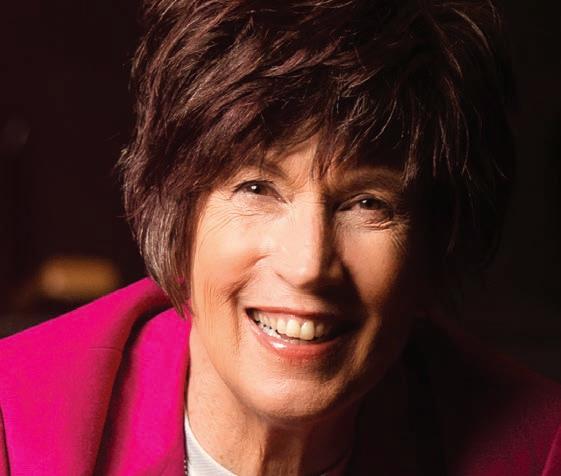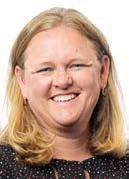Our in-depth look at the housing crisis



















A long-running con ict between Douglas County’s elected leaders could continue after county Commissioner Lora omas signaled she might take action to have her legal bills paid back if the county doesn’t decide to pay the cost.
Her two fellow commissioners on the board appeared not to entertain that idea.
“If you want to sue the county and cost the taxpayers more in legal fees, that is entirely up to you,” Commissioner Abe Laydon responded during a Jan. 31 meeting.

omas accused Laydon and Commissioner George Teal of conducting a “witch hunt” investigation into whether omas created a hostile working environment. omas said the investigation “exonerated me of any wrongdoing.”
If lawmakers don’t act to make housing more a ordable now, “we will soon face a spiraling point of no return.”




at’s what Gov. Jared Polis said in January, during his annual State of the State Address. He noted myriad problems linked to rising housing costs. People, he said, “are being forced out of their neighborhoods with no hope of ever living close to where they work.”
“ at means more tra c, lost
time and money spent on long commutes, more air pollution, and greater economic and workforce challenges,” Polis said. Polis added that rising housing prices are “putting the dream of homeownership out of range for more and more Coloradans.”










e governor’s assessment squares with the ndings of Colorado Community Media in our four-week series exploring what many experts say is a housing crisis — one that a ects practically everyone in the Denver area. Lower-income workers are seeing larger chunks of their paychecks
go to landlords. Young families can’t nd starter homes they can a ord. Retirees don’t see any attractive options for moving and downsizing, meaning their homes stay o the market, helping keep prices high.
“Just look west,” Polis said in his address. “In California, decades of poor planning has led to interruptions of drinking water and electricity for entire towns and cities, average home prices over $1 million in major cities and 16lane freeways” with “bumper-to-
SEE STRESSES,
At the center of the con ict are multiple layers of legal wrangling that stem from an investigation Teal and Laydon initiated after accusing omas of circulating an anonymous letter that criticized speci c employees in the Douglas County Sheri ’s O ce, allegedly creating a hostile work environment. ey also accused her of emailing county legal representation with a request not authorized by the full board.
e $17,000 investigation into omas by outside legal counsel found that while omas had distributed the letter, doing so did not create a hostile work environment. It also found she did direct legal representation to provide her with information the board had determined to keep secret.
omas appeared in a CBS Colorado news story in July discussing the con dential report that showed the results of the investigation, prompting the Douglas County government’s attorney to nd that omas could have broken the law by doing so.
SEE

When a woman chasing her dog out onto a frozen pond in Redstone Park fell through the ice into the frigid water on Jan. 10, two Highlands Ranch Metro District park sta leapt into action.
Tim Doan and Steve Albert, who were working in Redstone Park the day, called rst responders and then grabbed a hose that they were
able to throw to the woman in the pond and pull her to shore.
Both the woman and her dog were unharmed.
Doan and Albert were honored by the Highlands Ranch Metro District and South Metro Fire and Rescue on Jan. 31 for their response e orts.
South Metro Fire Cpt. Jake Mayhew praised Doan and Albert, calling them a combination of “something I’d expect from a professional responder and something from a MacGuyver script.”
O cials from South Metro and Highlands Ranch agreed that Doan
and Albert prevented a potential tragedy.
“It is without a doubt that their quick actions prevented catastrophe that day,” said Tammy Tucker, the director of parks, recreation and open space for Highlands Ranch Metro District.
Metro District General Manager Stephanie Stanley said she is proud to honor Doan and Albert .
“ ank you for everything you do for our community, but especially the actions of that day,” Stanley said.
South Metro Fire Rescue Risk
Reduction Specialist Selena Silva said people should assume that ice on ponds or lakes will not support the weight of a person. Ice may not be the same thickness all the way across the pond and even thick ice can be weak from warm temperatures or snow, Silva said.
People who have fallen into icy water can develop hypothermia within a few minutes, she said. Silva encouraged bystanders who see someone fall into icy water to call 911, tell the person to stay calm and make a visual note of where the person fell in.
A man died after a Littleton Police Department o cer shot him at approximately 1:05 a.m. on Feb. 2, police spokesperson Sheera Poelman said.

e o cer initiated contact with a man on a motorcycle at the corner of Bannock Street and Powers Avenue due to it being a suspicious vehicle.
e motorcycle was con rmed after the incident to be a stolen vehicle, Poelman said.
When the o cer attempted to contact the individual, the motorcycle driver crashed the motorcycle and ran on foot, then produced a handgun, Poelman said. e o cer then red his gun at the individual.
e individual was transported to a hospital and was later pronounced deceased, Poelman said.
e individual’s gun was not red during the incident, she said.
e Littleton Police Department did not provide information about the victim’s name, age or race. e department also did not provide information about the o cer’s name or race. Any time an o cer discharges a weapon, partnering agencies in the region come together to investigate the incident through what Poelman called the “shoot team.” is team is conducting an investigation of the situation.
e o cer is on paid leave until the investigation is complete, Poelman said.
Dear Davis Schilken,
I just recently proposed to my girlfriend (now fiancée) and now her parents insist the two of us sign a prenup before we get married. How can I appease my in-laws while still protecting my rights?
Sincerely, Perplexed by a Prenup
Dear Perplexed by a Prenup,
First off, let us congratulate your fiancée and you on your pending marriage. We hope your wedding day is as amazing as your life together will be!! Now, let’s get down to the business of nuptial agreements, which can either be done prior to or after marriage.
Marital agreements, both prenuptial and postnuptial, are a written contract executed between a couple to specify what will happen to the couple’s assets in the event of divorce or death.
Even if you build a happy, healthy marriage, one spouse will likely outlive the other. Marital agreements can give partners peace of mind about the financial future.
When you’re about to get married, divorce is the last thing on your mind. However, the reality is that between 40 and 50 percent of first marriages end in divorce. If you bring significant assets to your marriage or if your fiancée has significant debts, a pre-nuptial agreement is an important way to protect yourself financially. The attorneys at Davis Schilken, PC can draft a prenuptial agreement that details the assets and debts of both parties to be married and explain how property will be divided and support handled in the event of death or divorce. The agreement can encompass children’s and grandparents’ rights, if desired.
There are a few requirements that a nuptial agreement must meet before it becomes valid. These include the following conditions -
• The nuptial agreement must be written, signed, and notarized.
• The agreement must include valid disclosure of assets and financial obligations between both parties.
• Threats, force, or emotional duress must not have influenced the creation of the agreement.
• Terms of the agreement must not appear unethical or lacking fairness.
If nuptial agreements aren’t drafted correctly, they may do nothing but complicate things further.
Unfortunately, just because you have created an agreement in writing doesn’t mean that it is presumed to be valid or enforceable. Therefore, it’s crucial that you have a nuptial agreement reviewed by a qualified lawyer to ensure everything is executed properly.
Contact the Davis Schilken, PC team with any of your Estate Planning needs (303) 670-9855.


We offer no obligation in person or virtual meetings. We make estate planning simple!


Visit our comprehensive website for more tools www.dslawcolorado.com
The front doors of the Bemis Public Library in Littleton on Jan. 19, after the city closed it due to methamphetamine contamination.

e city of Littleton is conducting further testing in the Bemis Public Library after recent test results showed methamphetamine contamination in several restrooms.
e second round of testing started on Jan. 24 and is testing soft and common area surfaces as well as ventilation systems throughout the library.
City spokesperson Kelli Narde said the city had not yet received the results as of Feb. 1, but hopes to have them any day.
“Every day, we’re hopeful,” she said about receiving results soon. Contractors performed the rst round of testing, which focused on bathrooms, on Jan. 13 and the city received results on Jan. 18.
Zeal Environmental, a company that provides environmental testing and industrial hygiene services for asbestos, mold, lead-based paint and methamphetamine, is contracted to do the work for the city. e company declined to comment on what goes into the process of speci cally testing for meth in public facilities.
After the city receives the results, they will determine next steps regarding further testing and remediation, Narde said.
With more than 20 agencies and organizations coming together to o er a resource fair to county residents, the Douglas County Community of Care Network held the rst Strive to rive event of the year. e bi-annual Strive to rive event was held at Calvary Castle Rock. Nonpro t organizations and Douglas County agencies provided resources and services such as housing information and assistance, clothing, household supplies, medical care and a free meal.
In addition to clothes provided by Clover’s Closet and SECORCares food pantry, this year’s event included numerous ra e prizes, which included King Soopers and Sprouts gift cards.
An organization that has participated in multiple Strive to rive events, Manna Resource Center was back to o er holistic programs and community connection.
Manna Resource Center is a faithbased nonpro t organization under which Manna Connect operates. According to coach Lindsey Scherrer, Manna Connect provides individual coaching, career development, assists in the search of jobs and education and also serves as poverty alleviation for the area.
“I think just being able to connect with community members face to face, getting to share what we do and getting to hear what they are looking for, it’s a really unique way to meet folks within our community,” said Scherrer.
Among the vendors was the state’s largest nonpro t health care provid-



ers, Kaiser Permanente.
“I think it’s a good give back event,” said Kaiser Permanente representative Dan Wegner. “I like this event because it’s people that are needing the stu that these other vendors are bringing here.”
Karen Humble with Backpack Society found out about the strive event through the Community of Care Network.
is was the second year the nonpro t has participated in the event. With a goal to remove food insecurity, Backpack Society provides food to students on weekends and on long school breaks when students might go without food.


Backpack Society partners with schools in the Douglas County School District, the Littleton School District and the Cherry Creek School District. According to Humble, the society would like to work more closely with the school resource o cers of the schools to learn what the needs of the students are.
Participating at Strive to rive for the rst time was Life Connect, which is an initiative of Grace Chapel.
Life Connect is a six to 12 month program for people that are wanting to become more self-sustainable. In addition to meeting with a life coach, they provide a community dinner once a month to build community relationships.
According to life coach coordinator, Michelle Moss, as SNAP bene ts decrease, Life Connect will provide household and hygiene supplies through a Resource Pantry starting Feb. 5.
“I love connecting with all the other resources because we get a lot of variety of people that come to us, so I can now resource them to their speci c needs,” said Moss, “So there’s lots of collaboration in this group, which is really beautiful.”
Melanie Yazzie’s “Peace Walking” exhibition is open in the Freyer-Newman Gallery at Denver Botanic Gardens, 1007 York St., Denver, through May 29, 2023. e exhibit is based on Yazzie’s interpretation and meditation on the Dine’ (Navajo) prayer, “Walking in Beauty.” e exhibit features more than 40 paintings, prints and sculptures that draw on childhood memories, travel stories and more. She will speak at 6 p.m. on March 9 and there will be a reception from 5 to 8 p.m. on Feb. 24. Yazzie is professor of arts practices and head of printmaking at CU Boulder. Open with garden admission. See botanicgardens.org.
Littleton Museum
“Nature’s Blueprints: Biomimicry in Art and Design” is open at the Littleton Museum, 6028 S. Gallup St., Littleton, through March 15. It brings together art, design and environmental science and will have interactive learning stations as well as art, artifacts and photography. Free.
Call for artists





Call for Artists: Jurist open call at CORE Art Space, 6501 W. Colfax Ave., Lakewood: “Rose Colored Glasses” Feb. 17 to March 5. Juried by Dana Cain, who will jury pieces in a nation-


wide exhibit focused on what seeing the world through rose-colored glasses might mean to an individual artist. A glass half full? Filled with pink lemonade? Pink champagne? Gallery hours: Friday: 5 to 10 p.m.; Saturday and Sunday: noon to 5 p.m. See coreartspace. com.
Duke Ellington
“Duke Ellington’s Sophisticated Ladies” features music by Duke Ellington, celebrating his legacy: “Take the A Train” and other favorites. rough March 5 at Vintage eatre, 1468 Dayton St., Aurora. Performances: Friday/ Saturday, 7:30 p.m.; Sunday, 2:30 p.m. Directed and choreographed by Christopher Page-Sanders. 303-856-7830, vintagetheatre.org.
Englewood art show
Englewood Art Exhibit is open at the Malley Recreation Center, 3380 S. Lincoln St. in Englewood. Monday to ursday, 8 a.m. to 7 p.m.; Friday, 8 a.m. to 5 p.m.; Saturday, 9 a.m. to 1 p.m.
Stories on Stage
“An Afternoon with best-selling author Peter Heller” at 2 p.m. Feb. 19 at Su Teatro, 721 Santa Fe Drive, Denver. Actors Tim McCracken and Allison Watrous will read from Heller’s books and Heller will read from his novel “ e Dog Stars” and stay for a discussion afterwards. A virtual premiere will be available at 7 p.m. Feb. 23 and can be watched after that date. See storieonstage.org. Note: Su Teatro requires masks. For in-person attendees,

there will be an on-call list at the front table.
Littleton Symphony



Littleton Symphony will perform at 7:30 p.m. on Feb. 10 with guest conductor Brandon Matthews. Littleton United Methodist Church, 5894 S. Datura St., Littleton. Tickets: 303-9336824, littletonsymphony.org.
Wonderbound
“Reckoning at the Red Herring Tavern,” a new creation by Wonderbound
dance company Artistic Director Garrett Ammon, features original classic dance music by Tom Haggerman of DeVotchKa. March 2-12. Location: 3865 Grape St., Unit 2, Denver. 303292-4700, wonderbound.com. Note — some performances are sold out.
Town Hall
Next at Town Hall Arts Center: “I Love You, You’re Perfect, Now Change.” Feb. 17-March 19. 2450 W. Main St., Littleton. 303-794-2787, ext. 5, townhallartscenter.org.

VA Eastern Colorado Health Care System hosted a town hall at the Castle Pines Library Jan. 30 to discuss plans for the new Castle Rock VA Clinic and the expansions of the PACT Act and COMPACT Act.

Looking to open in late 2024 or early 2025, the Castle Rock VA Clinic will be a 20-year lease built at the northeast corner of Prairie Hawk Drive and Dacoro Lane.
e annual lease is estimated to be $1.3 million.
According to the director of the VA Eastern Colorado Health Care System Miachel Kilmer, the 20-year lease is a build to suit, meaning the contractor is going to take the VA’s design and build it based on the primary care model the VA wants.
“ e thing that makes me condent about the clinic is this is a build to suit,” said Kilmer. “ e landlord can’t start collecting rent until it’s built and we take occupancy. So, you’re going to have a motivated contractor.”
DCB Construction, the general contractor for the Loveland VA Clinic will build the Castle Rock VA Clinic.



e clinic is currently designed for eight primary care teams. However, Kilmer said they are going to reassess as they need to integrate mental health and whole health or complementary alternative medicines such as chiropractic, acupuncture and massage.
In addition to the eight primary care teams, the total space will be 25,000 square feet and look to include a lab service. e clinic will not o er in-house eye care, a pharmacy or a dedicated full time women’s health clinic. However, there will be a women’s health fellowship.
“Veterans can choose who their
providers are and I’m sure we’re going to have a combination of male and female providers at that clinic and they are all required to be certied in women’s health,”
Updates on the clinic will be provided through the veterans service organization, social media, the website and future town halls.
According to Kilmer, the PACT Act is expanding presumptive conditions in making eligibility easier for those who have been exposed to toxic airs, radiations, smoke pits, Agent Orange and other general hazards.
“We’ve already seen about 260,000 PACT Act related claims since the legislation was signed into law on August 10 (2022),” said Michael Rohrbach, director of the Denver VA Regional O ce.
Rohrbach encourages veterans to work with their county and state veteran service organization representatives and le a claim for PACT Act.
rough the Veterans Comprehensive Prevention, Access to Care, and Treatment Act of 2020, the VA will cover medical costs for veterans who receive emergency care for veterans who are at imminent risk of self-harm. e program started on Jan. 17. is includes ambulances and other transportation costs.
According to Kilmer, veterans are eligible for up to 30 days of in-paitent or crisis residential care and up to 90 days of out-paitent care including social work. e act will cover the cost of care if one is discharged after more than 24 months of active duty service and discharged under conditions other than dishonorable. e COMPACT Act, “extended out eligibility for emergency suicide care to veterans who were the victims of physical assault of a sexual nature, a battery of sexual nature or a sexual harrassment during their service,” said Kilmer.
holder. In this case, as a member of the Board of County Commissioners, Lora omas is a privilege holder,” Arapahoe County Sheri ’s O ce Sgt. Bruce Peterson wrote in a memorandum. omas held a news conference in November and called the probe “yet another bogus investigation.”
‘Forced to find legal remedies’
Whether the county is obligated to pay omas’ legal fees depends on whether she was acting in the scope of her duties or her actions were “willful and wanton.”
“If you believe that the actions of ( omas) were purposely pursued in order to likely result in harm to the county, then that would be willful and wanton,” Chris Pratt, interim Douglas County attorney, told the commissioners during the


Laydon argued Arapahoe County “got it wrong” in evaluating omas’ actions, saying “the privileged holder of a con dential document is the board” and not just one member of the board. He based his point on Pratt’s understanding of the law.

“ e release of a privileged document is not something an individual (commissioner) can do. Leaking something to the press is highly inappropriate,” Laydon said. “Commissioner omas has never indicated that she did not do that. Which, again, I think that lack of candor really speaks to the lack of trustworthiness that we’ve experienced here. So no, I am not interested in asking the taxpayers to spend money to defend willful and wanton action.”
An old court case that involved
and a board of county commissioners came up during the conversation.
“It was an argument over salaries for employees,” Pratt said. “In that case, the court ordered the board to pay for the legal fees for the treasurer’s o ce. e court felt it was inappropriate for the board to create a legal dispute and then require another elected o ce to pay.”
But Pratt was not sure the case applies to omas’ situation, given that the current dispute is within the Douglas board of commissioners itself rather than two di erent entities, he said.
omas was undeterred, arguing the situation is still the county’s responsibility.
“What I am saying is that if you decide to not follow the law and pay my legal bills, then I will be
forced to nd legal remedies to be made whole as the law allows,” omas said.
omas also said she was “willing to o er a compromise” to Laydon and Teal.
“If you two are willing to split the almost $23,000 that you cost the taxpayers, and you write a check to the county by Feb. 15 — if you’re really concerned about taxpayer dollars here — you each write a check for almost $11,500 to pay the county back for the frivolous $23,000 bill you charged them,” omas said. “After those personal checks clear, I will waive my right to my attorney’s fees.”
Laydon responded: “I want to be unequivocal that it was you that cost the taxpayers $23,000.”
“It’s your behavior. I don’t think George and I have any interest in engaging counsel to deal with misconduct of a commissioner,” Laydon said.
e allegations toward omas were based on the use of an anonymous letter sent to the commissioners on April 29, 2019, and whether the information in the document was used in her unsuccessful 2022 campaign for Douglas County sheri .

Recently, Laydon again accused omas in a Jan. 31 letter of leaking “classi ed” materials, pointing to the content of a story written by Colorado Community Media. Laydon did not specify what exactly in the CCM story he was referring to as being classi ed.
is story draws from Colorado Community Media reporting by Elliott Wenzler and Haley Lena.
Douglas County Commissioner Abe Laydon accused fellow Commissioner Lora omas of leaking classi ed materials regarding the board’s 2-1 vote to spend nearly $1 million for advanced metal detector technology at STEM School Highlands Ranch.
omas voted against the measure, saying the technology is not proven and she had concerns. Laydon and Commissioner George Teal voted to spend $961,000 for Evolv to install AI-enhanced metal detectors at STEM School Highlands Ranch, where a deadly shooting occurred in May 2019.
omas posted links to stories written by Colorado Community Media’s McKenna Harford and Hailey Lena in her weekly newsletter, which prompted Laydon to call South Metro Editor elma Grimes around 9 p.m. on Sunday, Jan. 29, claiming the articles are irresponsible, put students at risk and quoted “classi ed” materials.
Grimes disputed Laydon’s claims that reporters received any such documents or materials from omas or other commissioners. e reporters wrote stories based on the Jan. 24 public meeting where the vote was taken to spend the funds and through interviews and research.
Laydon still moved forward with accusations, accusing omas in a Jan. 31 letter of leaking “classi ed” materials. Laydon took particular issue with the story written by Harford, who wrote speci cally about the technology being funded by the commissioners. e well-sourced story quotes Evolv’s website, STEM School o cials, and other information available publicly through online searches, YouTube and documentation from the Jan. 24 meeting.
In the letter to omas, Laydon said he believes the public should only be given information about mental health and school resource o cers within the Douglas County School District. Even in cases where the county or school district approves spending millions of dollars during public meetings, Laydon said any school security information should not be available to the public.

“ e county has actively shared school security funding around mental health and school resource o cers as public awareness of those measures does not potentially place children at risk, but as you are aware and have repeated in our recorded work sessions, in an agreement with the Board of Education since the STEM shooting, the county has never publicly disclosed speci c school security details so that we don’t put students, sta , or administration at risk,” Laydon said in the letter.
Laydon also took issue with Colorado Community Media reporting about the FLOCK technology approved by the school district last year. While Harford wrote about the technology, no information on where the technology is located
proven useful for tracking down stolen cars.
In the letter, and in texts to Grimes, Laydon said he called Mike Peterson, president of the Douglas County School Board, about Harford’s attendance at school security meetings where Laydon said attendees sign non-disclosure agreements. Laydon said the meetings he references are not open to the public.
Grimes said Harford attends public meetings hosted by the school district, while noting the press was unaware of elected o cials holding security meetings where NDAs are being signed and that are not open to the public.
After quoting from the Douglas County Policy Manual section 2.3, Laydon ends the letter asking omas to answer whether she or her sta provided classi ed materials to Colorado Community Media reporters.
“ is is the second time in a matter of months that a privileged document protected in an executive session was leaked to the press,” Laydon wrote. “In the last instance in which county counsel indicated your behavior could be criminally charged, you have yet to a rmatively state that you did not leak that report. Such lack of candor gives me signi cant pause with regard to your trustworthiness and seeming willingness to repeatedly place the public interest over your own. Regrettably, this is yet another example wherein your self-motivated behavior and signi cant lack of judgment are undermining the good work of this county and board must reserve its right to take further action pursuant to the Douglas County Policy Manual.”
In 2022, with Commissioner George Teal voting in agreement with Laydon, omas was investigated twice regarding the alleged release of documents and other accusations.
e rst investigation cost the county $17,000 and omas was found to have distributed a letter, but did not create a hostile work environment.
In the second investigation, the Arapahoe County Sheri ’s O ce cleared omas of any wrongdoing.
In the most recent accusations, Laydon did not tell Grimes by phone what exactly he was referring to as “classi ed” in Harford’s story. He does not provide a speci c example in his letter to omas either.
As of Feb. 2, omas had not responded to Laydon.
Douglas County offices will be closed Monday, Feb. 20, 2023. Many services are available at DoItOnlineDouglas.com

Want to learn more about history, spend time appreciating abstract or contemporary art or get in touch with nature? SCFD organizations have your entrance fee and cultural passions covered. For more information, including specific dates and locations - visit scfd.org


Douglas County residents may dispose of unwanted electronics free of charge at Techno Rescue, 3251 Lewiston St. in Aurora. Drop off weekdays from 8 a.m. to 4:30 p.m., and occasional Saturdays from 10 a.m. to 2 p.m. Proof of residency is required. For a list of acceptable items, Saturday drop-off dates and more, visit douglas.co.us and search for Electronics Recycling.

Learn more at douglas.co.us/snow
Eligible low-income households in Douglas County may apply for energy assistance through the Low Income Energy Assistance Program (LEAP). Visit douglas.co.us and search LEAP for more information or an application, or email LEAPHELP@discovermygoodwill.org

Construction to widen the road between Highlands Ranch Parkway and C-470 is underway. Please expect delays and watch for crews. Sign up for updates so you know what to expect. Visit douglas.co.us and search for Subscribe Now and choose US 85 construction.
Consider giving that time to change the life of an older adult by volunteering with Aging Resources. You can help with transportation, go grocery shopping or provide company for older adults. For more information, visit agingresourcesdougco.org
An alleged campaign nance complaint led by Douglas County Commissioner Lora omas for political postcards claiming she was wasting taxpayer time and money has been dismissed by the Colorado Secretary of State’s O ce.
Earlier in January, omas led a complaint against Vistaprint, the company that printed the postcards, because there was no indication who sent them and no paid-for-by disclaimer, which is required by law on certain political communications.
e Secretary of State’s O ce ruled the postcards did not violate campaign nance laws because there’s no evidence Vistaprint paid for the postcards and the postcards were mailed after the election. e ruling also found no evidence that the mailers cost more than $1,000, which is the threshold for requiring a paid-for-by disclaimer on election materials.
In its response to the complaint, Vistaprint’s attorney said 153 postcards were ordered for a total of $248, but didn’t provide information about who the customer was.
omas told Colorado Community Media that additional postcards have come out since her complaint
Colorado Community Media welcomes letters to the editor. Please note the following rules:
• Email your letter to letters@coloradocommunitymedia.com. Do not send via postal mail. Put the words “letter to the editor” in the email subject line.

• Submit your letter by 5 p.m. on Wednesday in order to have it considered for publication in the following week’s newspaper.
• Letters must be no longer than 400 words.
• Letters should be exclusively submitted to Colorado Community Media and should not submitted to other outlets or previously posted on websites or social media. Submitted letters become the property of CCM and should not be republished elsewhere.
• Letters advocating for a political candidate should focus on that candidate’s qualifications for o ce. We cannot publish letters that contain unverified negative information about a candidate’s opponent. Letters advocating for or against a political candidate or ballot issue will not
was led and called the postcards despicable.
“ ey won’t put their name on it because they are ashamed of what they are doing,” omas said. “ ey don’t upset me.”
ough one of the postcards
omas identi ed in her complaint encouraged voters to support state Sen. Kevin Van Winkle to replace her, omas said she con rmed with Van Winkle that he is not paying for the mailers. omas said she wouldn’t accuse anyone of sending the postcards without evidence.
“ e fact that these people are so ashamed of this that they’re going to great lengths to hide their identity speaks volumes of who they are,” she said.
A recent postcard criticized omas’ vote against funding a school security pilot program at STEM School Highlands Ranch. omas voted against funding the program because of concerns about the technology’s e ectiveness. e postcards that omas originally led the complaint about told voters “You’re being scrooged by Lora omas,” claiming she is working with Democrat state Rep. Bob Marshall to expand the Board of County Commissioners from three people to ve people. omas said she wouldn’t let the postcards get in the way of her job, but would continue to push back against the misinformation they contain.
be published within 12 days of an election.

• Publication of any given letter is at our discretion. Letters are published as space is available.
• We will edit letters for clarity, grammar, punctuation and length and write headlines (titles) for letters at our discretion.

• Please don’t send us more than one letter per month. First priority for publication will be given to writers who have not submitted letters to us recently.
• Submit your letter in a Word document or in the body of an email. No PDFs or Google Docs, please.
• Include your full name, address and phone number. We will publish only your name and city or town of residence, but all of the information requested is needed for us to verify you are who you say you are.
• Letters will be considered only from people living in Colorado Community Media’s circulation area in Adams, Arapahoe, Clear Creek, Denver, Douglas, Elbert, Jefferson and Weld counties.
• Do not use all caps, italics or bold text.

• Keep it polite: No name calling or “mudslinging.”
The Colorado Sun is a journalist-owned, award-winning news outlet that strives to cover all of Colorado so that our state — our community — can better understand itself.
In this way, The Sun contributes to a more vibrant, informed and whole Colorado.
The Sun, launched in 2018, is committed to fact-based, in-depth and nonpartisan journalism. It covers everything
from politics and culture to the outdoor industry and education.
Now, The Colorado Sun co-owns this and other Colorado Community Media newspapers as a partner in the Colorado News Conservancy. The Sun is CCM’s partner for statewide news.
For Colorado Sun stories, opinions and more, and to support The Sun’s misssion as a member or subscriber, visit coloradosun.com.





Award-winning artistic director/choreographer Kyle Abraham brought the A.I.M. dance company to the Newman Center at the University of Denver for an exceptional evening of contemporary dance on Jan. 27.
“An Untitled Love,” a powerful new work by Abraham, was set to music by R&B legend D’Angelo. Abraham, who is presently the Claude and Alfred Mann Endowed Professor in Dance at the University of California’s Glorya Kaufman School of Dance, said he has worked on the new “An Untitled Love” for four years.
“I fell in love with D’Angelo’s debut album, `Brown Sugar,’ when I was an undergrad at Morgan State University, a Historically Black University in Baltimore, in 1995,” Abraham wrote.
















“Within his songs existed the histories and Neo-romanticism of Black Love in America. e same year marked the Million Man March, a de ning moment for Black men in the U.S. to unite against injustice. As part of my extended exploration of personal identity through the movement, it feels important for me to dive into a process that explores and celebrates that unity and that love, in all its facets.
“Ultimately, this work is dedicated to my parents, family (extended and immediate), to the cousins, aunts and uncles who aren’t blood related, but who we call family all the same,” Abraham wrote.



e stage was bare, except for a



















somewhat worn, fabric-covered sofa, angled at one side. Music and dancers lled the space at times and each of the 10 AIM members danced individually at other times, as D’Angelo and the Vanguard’s music owed.

“ is creative exaltation pays homage to the complexities of self love and Black love, while serving as a thumping mixtape celebrating our culture, family and community,”
Abraham wrote in describing the intensive project.
Abraham, a MacArthur Fellow (2013), grew up in Pittsburgh, then headed to New York, where he earned a BFA from SUNY Purchase and an MFA from NYU Tisch School of the Arts. He later received an honorary doctorate in ne arts from Washington Je erson College. His dance training began at Pittsburgh’s Civic Light Opera Academy and the Creative and Performing Arts High School in that city.
Prior to USC, Abraham served as a visiting professor in residence at the University of California Los Angeles’ World Arts Cultures in Dance program (2016 to 2021).
A.I.M. was founded in New York City in 2006 and the dancers who appeared at the Newman Center were: Jamaal Bowman, Tamisha

A. Guy, Catherine Kirk, Jae Neal, Donovan Reed, Martell Ru n, Dymon Smara, Kar’mel Antonyowade Small, Keturah Stephen and Gianna eodore.
One additional contemporary dance program remains in the Newman Center Presents series for this season: e Paul Taylor Dance Company on March 27. e remaining performances vary widely from e Philip Glass Ensemble to Kodo to e Mingus Big Band. See newmancenterpresents.com. e box o ce number is 303-871-7720.
An accomplished standup comic from Denver, CO, Christie Buchele has made a name for herself by sharing the heart-wrenching and hilariously raw realities of being a woman with a disability and proves time and again you can say almost anything with a smile on your face!

‘An Untitled Love’ is new work by Kyle Abraham


































 BY ELLIS ARNOLD ERANOLD@COLORADOCOMMUNITYMEDIA.COM
BY ELLIS ARNOLD ERANOLD@COLORADOCOMMUNITYMEDIA.COM

Residents in the south Denver metro area may have felt confused when they received a letter from their re ghting agency about an “amended service plan.”






e letter from South Metro Fire Rescue contained legal language and pointed to upcoming public meetings of county leaders who would vote to approve or deny the proposed changes.
But residents shouldn’t expect any changes to the services they receive when they call 911 in an emergency, according to Mike Dell’Orfano, a South Metro Fire o cial.
e proposed amendment is “just recognizing that we might be offering the same services, but over the past 55 years, the volume, the expertise, the types of incidents have all evolved,” said Dell’Orfano, the agency’s chief government a airs o cer.






It also aims to “take a new snapshot at what’s in our re district: the hazards, the number of cities, the population, all that,” said Dell’Orfano, who described the proposed change as something that occurs “in the background” from an administrative and legal perspective.
A lot has changed for South Metro Fire Rescue in ve decades. e agency’s original service plan dates back to 1967, when the organization was known as Parker Fire Protection District. e old agency served about 2,000 residents over 105 square miles in portions of Arapahoe and Douglas counties.
Now, South Metro Fire Rescue covers 560,000 people over 285 square miles, stretching over much of the south Denver metro area after many re protection agencies combined over the years to form today’s agency.
It now covers many cities and towns, including Bow Mar, Castle Pines, Centennial, Cherry Hills Village, Columbine Valley, Fox eld, Greenwood Village, Littleton, Lone Tree and Parker, along with nearby

unincorporated portions of Arapahoe, Je erson, and Douglas counties. “Unincorporated” means an area doesn’t sit within a city or town.










Since the agency’s start decades ago, its original service plan was amended a couple times to account for the ability to take on debt and to make sure all its services were re ected, Dell’Orfano said. ose amendments occurred in 1983 and 1996.
“As of right now, we don’t have debt, and we haven’t used debt to fund major capital projects for several years,” Dell’Orfano said. “Capital” costs include paying for re trucks, re stations and ambulances, for example.
e proposed amendment won’t

change the way the agency spends money, and it won’t change South Metro Fire’s hiring ability or the pay that employees receive, Dell’Orfano said.
South Metro Fire’s property tax rate — the mill levy that property owners in the re agency’s service area pay — would not increase as a result of the amended plan.
Some residents in the area did see small changes to their property tax rates in recent years when elections in 2018 decided that the City of Littleton, the nearby Littleton Fire Protection District and the Highlands Ranch Metro District would be absorbed into South Metro Fire Rescue.

( e Littleton Fire Protection District had included west Centennial, among other areas near Littleton.)


At the time, for example, Highlands Ranch homeowners saw a net property tax increase of 2.25 mills after being absorbed by South Metro Fire — or about $6.75 more per month on a house valued at $500,000.




But back then, those three entities knew they would eventually have needed to raise taxes to maintain their current services if they didn’t
join forces with South Metro Fire, Dell’Orfano said.
Cunningham Fire Protection District, which served a part of Arapahoe County, also joined South Metro Fire in the past several years, but the Cunningham area saw a tax decrease as a result, Dell’Orfano said. Taxes weren’t the only factor at play in the transitions, he noted.
“If all else was the same, there would have been no reason to ask their voters to pay more,” Dell’Orfano said. “It was also determined there would be improved service, improved re ghter working conditions, better nancial stability and a more sustainable organization into the future.”
Leaders in the three counties over which South Metro Fire Rescue spreads will hold public meetings on the proposed change in the coming weeks.
e Douglas County commissioners will meet at 2:30 p.m. Feb. 21 at 100 ird St. in Castle Rock.




e Arapahoe County commissioners will meet 9:30 a.m. Feb. 28 at 5334 S. Prince St. in Littleton.








Je erson County’s commissioners will meet 8 a.m. Feb. 28 at 100 Je erson County Parkway in Golden.

Thu 2/16
ARTS: Mini Picasso @ Harvard Gulch
@ 5pm Feb 16th - Mar 16th





Harvard Gulch Recreation Center, 550 E. Iliff Ave., Denver. 720-913-0654
ARTS: Preschool Pottery @ Harvard Gulch @ 6:15pm Feb 16th - Mar 16th
Harvard Gulch Recreation Center, 550 E. Iliff Ave., Denver. 720-913-0654
Fri 2/17
School Break Camp - 2/17 @ 7:30am / $45 Parker Fieldhouse, 18700 E Plaza Dr., Parker. 303-805-6315

Sat 2/18
Dave Mensch - Tailgate Tavern - Parker, CO @ 4pm


Tailgate Tavern & Grill, 19552 Mainstreet, Parker Teague Starbuck @ 5pm Sunroom Brewing, 3242 S Acoma St, En‐glewood

Journey Girls Live at Herman's Hideaway @ 7pm Herman's Hideaway, 1578 S Broadway, Denver
Vamonos Pest/Mobro: Mobro at Brewability Lab @ 6pm Brewability Lab, 3445 S Broadway, Englewood

Denver: Amit Tandon Stand-Up Comedy Live 2023 @ 7pm






Rock Canyon High School, 5810 McArthur Ranch Rd, Littleton
Lusid: Flight of the Dojo w/ Dillard @ 9pm the dojo denver, 665 Depew St, Lakewood
Sun 2/19
Tianna Esperanza @ 7pm Swallow Hill, 71 E Yale Ave, Denver

Mick Flannery @ 7pm Swallow Hill, 71 E Yale Ave, Denver
Mon 2/20
Last Call Romance: Hearts & Hops Sock Hop @ 6:30pm Lone Tree Brewing Company, 8200 Park Meadows Dr #8222, Lone Tree

Adam Ezra Group: A Solo Acoustic Evening with Adam Ezra at The Schoolhouse **POSTPONED** @ 7:30pm

The Schoolhouse at Mainstreet, 19650 Mainstreet, Parker
BAILE DEL DIA DEL AMOR Y LA
AMISTAD @ 8:30pm / $50-$60 Stampede, 2430 South Havana, Aurora
Samia w/ Tommy Lefroy @ 8pm
Gothic Theatre, 3263 South Broadway, Englewood
Tommy Lefroy @ 8pm Gothic Theatre, 3263 S Broadway, Engle‐wood
Tue 2/21
Handwriting: Pre-Writing (3 to 5 yrs) W/S23 @ 11:30pm

Feb 21st - Mar 28th
Parker Recreation Center, 17301 E Lincoln Ave., Parker
Wed 2/22
Loktavious @ 7pm
Herman's Hideaway, 1578 S Broadway, Denver
Eric Golden @ 8pm

Sheabeens Irish Pub, 2300 S Chambers Rd #A, Aurora
The Doo Wop Project @ 8pm Lone Tree Arts Center, 10075 Commons St, Lone Tree
Dear Marsha,: Chicks with Picks! DM ALBUM RELEASE with No Small Children, Melissa Crispo, Bug Frances @ 7pm Wild Goose Saloon, Parker

LATRICE ROYALE @ 8pm Gothic Theatre, 3263 S Broadway, Engle‐wood
Pretend Friend @ 9pm
The Englewood Tavern, 4386 S Broadway, Englewood
Thu 2/23
Art: Hands-On Introduction to DSLR Photography (16+yrs) @ 2am Feb 23rd - Mar 22nd PACE Center, 20000 Pikes Peak Avenue, Parker

Stephen Pearcy @ 8pm
Wild Goose Saloon, 11160 S Pikes Peak Dr, Parker
We are fully emerged into February, the month each year when medical professionals and healthcare organizations try to bring more awareness to heart health. While it should be a year-round priority for everyone, February is speci cally aimed at putting a focus on cardiovascular health.
I am extremely proud of my name. To be called “ elma” comes with some pride every time I hear it. You see, I was named after my grandmother who died months before I was born. As I am often told, my grandmother wanted a granddaughter so badly.
I never go to meet her. So, I got the next best thing — her name.
My grandmother was 50 years old when she died of a heart attack. My mom’s side of the family is a mess when it comes to genetic health, but the heart is the biggest concern.
My mom was afraid to turn 50 because of heart issues that owed through her family. When 50 came and went — she was relieved, but she de nitely keeps up with heart testing and taking preventative measures. For me, now in my 40s, I tend to ask my doctor a lot of questions about my heart. I share a name with a woman I never met because in the 1970s there was a lot less information available to people about heart health.
ere really wasn’t a month aimed speci cally at raising hearth health awareness.
A heart problem can be sneaky, since symptoms can present di erently in every individual. Someone with heart disease or heart failure may not experience the same symptoms as another person with the same condition.
While breast cancer tends to get a lot of attention in terms of women’s health and preventative measures — heart disease is actually a bigger culprit each year.
According to the CDC, despite e orts to increase awareness, only 56% of women recognized heart disease as the top killer. As the leading cause of death for women in the U.S., heart disease was responsible for 314,186 women dying in 2020. at equates to 1 in every 5 female deaths.
For personal reasons I write about women, but in reality, heart disease has a huge e ect on the entire U.S. population.
According to the CDC, one person dies every 34 seconds in the U.S. of cardiovascular disease. In total, 697,000 Americans died in 2020 of heart disease. at equates to 1 in every 5 deaths.
According to the CDC, the term heart disease refers to several types of heart conditions because it all goes toward issues a ecting the blood ow around the heart. Decreased blood ow, for instance, can cause a heart attack.
Sometimes heart disease can go completely unnoticed and undiagnosed until a person su ers from a heart attack, heart failure or arrythmia.
Instead of waiting for something major to happen, health o cials continue to stress the need to be proactive in healthcare, meaning taking preventative measures and tests as directed each year.
For more information on issues of the heart, visit the American Heart Association website at heart.org.
elma Grimes is the south metro editor for Colorado Community Media.

LINDA SHAPLEY Publisher lshapley@coloradocommunitymedia.com
MICHAEL DE YOANNA Editor-in-Chief michael@coloradocommunitymedia.com

THELMA GRIMES South Metro Editor tgrimes@coloradocommunitymedia.com
MCKENNA HARFORD Community Editor mharford@coloradocommunitymedia.com
Starting in 1996 I began living in Highlands Ranch and in 2001 bought a small a condo in Edwards, Colorado. The elevation in Highlands Ranch is about 5,800 feet, and Edwards is just over 7,500 feet. Coming from sea level on the East Coast, it took a little time to acclimate to the elevation. And soon enough all was well and everyone was just fine.
Having spent the past few years traveling back to the East Coast and
Support pet bill
Many of us know rst-hand the challenges of nding housing or homeowners insurance if we have a pet. House Bill 23-1068 would offer important assistance to help pet owners, which in turn would help keep more families housed and keep animals out of shelters. HB 23-1068 has several important elements. It would prohibit pet security deposits for renters while creating a damage mitigation fund to help landlords if needed. It would require landlords to contact animal control if a pet is left behind during an eviction. It would require a ordable housing developments to allow pets if they want to receive the Colorado Housing Tax Credit. And, last but not least, it would prohibit in-
ERIN ADDENBROOKE Marketing Consultant eaddenbrooke@coloradocommunitymedia.com






AUDREY BROOKS Business Manager abrooks@coloradocommunitymedia.com
ERIN FRANKS Production Manager efranks@coloradocommunitymedia.com
LINDSAY NICOLETTI Operations/ Circulation Manager lnicoletti@coloradocommunitymedia.com
spending most of my time at sea level again, I knew coming back to Colorado was going to be an adjustment, but since I work out, and have been back skiing, I didn’t think much of it.
Well, what I didn’t realize is that the house I would be living in for five weeks was situated at 10,200 feet. Skiing at 11,000 feet or 12,000 feet never really impacted
SEE NORTON, P13
surance companies from using the breed of a dog to deny housing insurance. is last point is key. Evidence shows that the breed of a dog is not the determinant of aggressive or destructive behavior. Individual dogs are individuals — just like people. Insurance companies would still have the power to deny insurance if an individual dog’s behavior is a problem, but it would prevent breed discrimination, and that in turn would keep thousands of dogs from ending up in shelters because their owners can’t get insurance.
Please let your state legislator know: vote yes on HB 23-1068.
 Diana Shubart Highlands Ranch
Diana Shubart Highlands Ranch
Columnists & Guest Commentaries
Columnist opinions are not necessarily those of the Herald. We welcome letters to the editor. Please include your full name, address and the best number to reach you by telephone.
Email letters to letters@coloradocommunitymedia.com


Deadline Wed. for the following week’s paper. To opt in or out of delivery please email us at circulation@ coloradocommunitymedia.com






 BY HALEY LENA HLENA@COLORADOCOMMUNITYMEDIA.COM
BY HALEY LENA HLENA@COLORADOCOMMUNITYMEDIA.COM
When it comes to heart disease, a local cardiologist says it is never too early to check to get checked out. According to experts, heart disease comes in many forms. as there are various types of heart disease and can present itself differently to each individual.

“All these cardiac risk factors put you at high risk of having heart disease, whether that’s high blood pressure, whether that’s cholesterol issues, diabetes, history of smoking,” said Dr. Je Park, a cardiologist with Aurora Denver Cardiology Associates at e Medical Center of Aurora. “I think that all encompasses what heart disease really is.”
According to the Centers for Disease Control and Prevention, coronary artery disease (CAD) is one of the most common types of heart disease in the U.S. In 2017, heart disease was the second lead-











me because I didn’t stay at that elevation for long as heading down the mountain was the goal, not camping at 12,000 feet. The home I am staying in has an awesome view. Now that I have acclimated I am enjoying it so much more as the views on a blue-sky sunny day are phenomenal. And with the amount of snow we have received, the mountains seem more majestic than ever.
Living at 10,200 feet brings with it a few extra benefits as the solace and quiet bring a sense of tranquility that escapes us in and around any city we may find ourselves living in. The rush and crush of daily life down at lower elevations is replaced up here with the hush of the wind whispering through the pine trees. It’s one of the most refreshing and relaxing places I have ever had the privilege to work from, even as I take calls, virtual meetings with customers and team members, while also finding time to write.
There is something else I have noticed, the people who live up here are used to living and rising above the noise and chatter going on in the city, in the news, and on social media. Not that there aren’t any concerns about the realities of life, they simply choose to find their peace by letting what others think about, worry about, and post about, to do it somewhere else and not up here.
Stopping into the local saloon there are people actually having conversations and not glued to their phones. Conversations are happening about the snowfall, the skiing, snowmobiling, snowshoeing and other pleasures of living
in the mountains. And not just during winter, I have heard all the stories of fishing, hunting, hiking, mountain biking, hang gliding and golfing in the other seasons. Since I have lived up here for this brief time and have tried to settle in with the locals, I haven’t heard any conversations about politics from either side, no discussion of the pressures of society, and no attacks on anyone in the small town or community.
When they talk, they talk about family, friends, travel, life experiences, the fresh mountain air and how they still stand in awe and wonder at mountains and sights all around them from the snowcovered mountains to the turning of the aspen leaves as the yellow of the aspens melds softly into the brightness of the evergreens. They talk about fly-fishing the rivers, and as one gentleman shared, he didn’t even care if he went out and came back without any fish. To just stand in God’s handiwork, quietly admiring all the nature surrounding him, was equally rewarding.
We can’t all go live at 10,200 feet, but we can all choose to rise above the noise and escape the rush and crush happening all around us. Are you part of the noise or part of the peace? Can you use a break from it all and find a little more quietness? I would love to hear your story at gotonorton@sandler.com, and when we can rise above the noise to find solace, peace, and tranquility, it really will be a better than good life.
Michael Norton is an author, a personal and professional coach, consultant, trainer, encourager and motivator of individuals and businesses, working with organizations and associations across multiple industries.

ing cause of death in Colorado.



Heart arrhythmia, heart valve disease and heart failure are among the many types of heart disease.
Park said high blood pressure is a major risk factor for heart disease. .




With high blood pressure, there is more pressure on the arteries and as people age, they harden. When the arteries harden, the blood cannot move as easily.
“You take a garden hose and you turn the water on and that water’s kind of free owing, and that’s your heart vessel when you’re young,” said Park. “And then when you start taking your hand and your thumb and put it over the end of that garden hose, the pressure in the hose starts increasing, the water starts owing a little bit faster, and a bit harder.”
Problems arise when the arteries harden too much, causing the pressure to be too high. When this happens, the heart has to work overtime. Park says it is the long standing e ects of high blood pressure that concerns cardiologists. e heart having to work overtime can often cause what is
called, demand ischemia. According to Park, this is when the heart and the demand and the supply of the heart are mismatched and the heart has to work overtime in order to overcome those high blood pressures.

Symptoms of heart disease can be di erent for everyone..



“I see a lot of patients who just have very vague symptoms,” said Park. “ ey’re like, ‘I just couldn’t sleep well. I just kind of felt there’s a weird kind of sensation in my chest and you know, it wasn’t anything severe and it kind of moved up my neck’.”
According to Park, one can never be too sure about the heart, therefore, it is worth going to get a check up and a test.
ose experiencing chest pain and seeking medical attention will typically have an EKG done to monitor the heart rhythm. Special marker’s of a heart attack will show up in blood work said Park.
“If you notice something’s changed, I think that’s the time where you really reevaluate that decision and say, ‘maybe it’s not the worst thing just to kind of reassure myself’,” said Park.


For a month, our reporters and editors brought you stories of your neighbors, your wouldbe neighbors and even people who struggle to survive under bridges. We are all a ected by the rising costs of housing across the Denver area.
e problem is clear: Prices for homes and rents have skyrocketed in recent years. And though the trend shows signs of leveling out, prices are nothing like they were just a few years ago. Jumps in values of hundreds of thousands of dollars were common in the past ve years. For instance, in Brighton, northeast of Denver, and in Littleton, to the south, home values rose $225,000-$300,000, respectively, between 2017 and 2022. Renters are also giving more of their paychecks to their landlords.
Experts at Denver-based Root Policy Research, which studies housing issues, say 700,000 Colorado families are “cost burdened.” e term describes households that devote 30% or more of their income to rent or mortgages. Alarmingly, even families earning as much as $75,000 can be considered burdened.
is week, we look at potential solutions, starting with some

bumper tra c.”
e governor then pivoted to what he sees as solutions. Since 2019, he said, billions of dollars have been invested in housing. For instance, American Rescue Plan Act funds have gone toward projects around the state, he said. And Colorado voters in November passed Proposition 123, which is expected to bring hundreds of millions more dollars to a ordable housing e orts in the years ahead.
“But we can’t just buy our way out of this,” Polis added.
Public o cials, he said, need to break down rules that stand in the way of building more housing.
at idea resonates with ex-

espoused by Jared Polis, the Democratic governor who last month surprised us with his intense focus on housing during his annual State of the State Address. Colorado “will soon face a spiraling point of no return” if housing remains on the course that it is now, Polis said.

Senior Reporter Ellis Arnold rushed to the Capitol for Polis’ news conference after the speech, getting a few o -thecu answers. Billions of dollars have already been spent in recent years to make housing more a ordable, the governor says. He highlighted federal American Rescue Plan Act funds, the stimulus that came during the COVID-19 pandemic. Also, Colorado voters in November decided to earmark hundreds of millions of dollars a year through Proposition 123, which backs local housing affordability e orts.
Yet, for all the tax dollars involved, the governor says, “We can’t just buy our way out of this.” Local rules, like zoning, need to be addressed too, he said.
Experts have told our reporters the same. Reporter McKenna Harford looks at how changes to zoning, among other strategies, can make housing more a ordable. Meanwhile, reporter Luke Zarzecki looks at how the development of our
perts like Christy Rogers, who teaches housing policy at the University of Colorado Boulder.
“Where are our starter homes?” Rogers said. “Where’s our ability to provide housing for a bunch of di erent income levels?”

Many communities need more variety. Some need more density, housing units built closer together, she said.
Housing advocates often point to “the middle,” homes that are neither large, singlefamily units nor big apartment complexes. e middle consists of smaller single-family units and condos that get people their rst foothold in homeownership, a home that they can build equity in and, as their family grows, sell and reinvest the pro ts to upgrade to a bigger one.
e governor appears to be

cities contributes to healthharming pollution and how ideas like better-planned transit can improve our air and reduce climate change. Reporters Belen Ward and Steve Smith look at tiny homes and how di cult it can be to nd a home, even with some help.
In the end, there is no one solution and, frankly, the problem looks like it will continue, and potentially worsen, in the months ahead. Yet we acknowledge e orts to reverse the trend, including collaborations between federal, state and local o cials on myriad projects in our communities. We also hope that they are successful and that Colorado does not turn into what Polis decries — his portrayal of California as a poorly-planned nightmare, where residents face shortages in drinking water, commute on clogged highways and pay $1 million for a typical home.
In the months ahead, we plan to follow up with o cials and hold them accountable for their promises to improve the situation. We will ask for speci cs and then seek out local leaders and residents for their reactions. We also plan forums where our readers and local leaders can join us to speak about the work that needs to be done. In the meantime, we welcome your letters with ideas.
headed in a direction where that kind of market is more possible. He said he wants to “legalize more housing choices for every Coloradan” while “protecting the character” of the state.
Yet it is an idea marked mostly by the sweeping language of the governor’s speech — at least for now.
Colorado Community Media asked the governor for more details since his address. In one statement, the governor said only that “across our state we need more housing for purchase and for rent at a lower price, and I look forward to working on all ways we can help make this happen.”

In another sign, the governor touted Lakewood’s “forwardlooking vision” after he visited

Aldjia Oudachene’s Littleton home is “a wish come true.”
e house is close to the school bus stop, near work and even has a guest room where Oudachene’s father stays when he visits.
“We have good neighbors who have children the same age, so they play together and I’m so happy here,” Oudachene said.
Originally from Tizi Ouzou, Algeria, Oudachene, her husband and two children moved to Littleton in October 2020. In Algeria, Oudachene’s family lived in a house they could a ord on her and her husband’s incomes as French teachers. When they moved to Littleton, Oudachene said it was a challenge.

“When we came here, we started our life from nothing,” she said. “Here, to teach French, I have to learn English rst.”
To make ends meet, Oudachene and her husband took full-time positions with Walmart, but, even then, the high cost of housing put homeownership outside of their budget. Instead, they rented a two-bedroom apartment.
“With the apartment, life was stressful for us,” she said. “ ere wasn’t a lot of space and no place for (the children) to play.”
Oudachene’s family needed more space and privacy. So they kept looking for a house. Oudachene said her family friend told her about Habitat for Humanity. e national nonpro t vision is a “world where everyone has a decent place to live.” And a ordability is a major part of the organization’s vision. e application process took about a year, but Oudachene said there was no way her family would have a house without Habitat for Humanity Metro Denver’s help. In the end, the organization provided an opportunity for the family to invest in a home within their budget.
“We would have had to wait to have the budget without Habitat,” she said. “It was so fast. Now, I’m happy to pay the mortgage because it goes into our home.”
From 2017 to 2022, the average home price in Littleton has gone up $300,000, but the city is not alone. Over the same period, Brighton saw home prices increase $225,000, Arvada saw a $275,000 increase and Lone Tree homes are up more than $470,000 on average.
As nding a ordable housing becomes harder for a growing number of Colorado families, municipalities and nonpro ts are looking to expand existing solutions like inclusionary zoning, community land trusts and deed restrictions.
Communities that have implemented one or more of these approaches report increasing their a ordable housing stock, though ofcials emphasized that the complexity of Colorado’s housing situation means there is no silver bullet.
However, across the board, a key element to getting support for the expansion of a ordable housing
programs is changing the mindset of who bene ts from them.
Supply, but for whom?
Another impact of rising housing costs throughout the metro area, many communities are reaching a critical point where a majority of workers can’t a ord to live where they’re employed.
Corey Reitz, the executive director for South Metro Housing Options, an a ordable housing provider that serves Littleton and Arapahoe County, said housing prices are now una ordable even for people who take home a solid paycheck. at includes earners topping $82,000, the median household income in Adams, Arapahoe, Douglas and Jefferson counties, according to data from the Colorado Housing and Finance Authority.
“In the past there was an a ordability issue around those lower (area median incomes), but we’re to a point right now where a ordability impacts so many people across a larger spectrum,” Reitz said.
Across the state, the share of housing a ordable to Coloradans has dropped signi cantly. In 2021, just 51% of the state’s housing stock was a ordable for median income earners. at’s down from 76% in 2015, according to research from the Colorado Futures Center, a nonpartisan research group out of Colorado State University.
Phyllis Resnick and Jennifer Newcomer, the authors of the study, said they believe the continuous rise in pricing, even as the housing supply grows, indicates a mismatch in the kind of housing needed and the kind of housing being built.
“ ere’s supply, but supply for who? At what monetary level?” Newcomer asked.
It looks like this: subdivisions of four- and ve-bedroom homes, handfuls of luxury apartments and few, if any, condos and starter
homes.
“ e thing that we’re trying to gure out how to illuminate most speci cally is this nuanced distinction between total rooftops and this notion of supply with respect to availability,” Newcomer said.
Resnick said the current market doesn’t incentivize the construction of lower-cost housing. Per her 2021 analysis, housing values in Colorado would need to drop by roughly onethird to return to the 2015 levels of a ordability – something unlikely to happen, experts have told Colorado Community Media throughout our four-week housing series.
e ones feeling the crunch the most are those who earn the least money, though many of those struggling to a ord housing have aboveaverage salaries.
“I suspect when we nish our research, we’re going to nd that housing that is a ordable to people who are closer to the economic margins is sort of not feasible in the sense of being pro table for the folks who need to be out there building that housing,” Resnick said.
Without the market providing entry-level housing or starter homes, nonpro ts and local governments have stepped in to try to ll the gap by subsidizing building and buying costs.
An extreme example is the city of Golden, where 95% of its workforce lives outside city limits.
Just this month, the city applied for a grant to support a $65 million partnership with Habitat for Humanity to construct 120 for-sale condos and townhomes for residents making 80% of the area median income for households. at’s roughly $65,000 for an individual and around $93,000 for a family of four.
Golden recently completed a housing needs assessment in October, which found that both housing
prices and rent increased exponentially in less than a decade. e cost of the average house in the city doubled between 2015 and 2022. For the rst half of 2022, the average single-family home sold for $1 million, up from $533,000 in 2015. is means even relatively highincome earners in Golden are considered by the city to be burdened by housing costs.
“ e majority of the housing that we’re projected to need in the next 10 years will need to serve households at or above 120% area median income,” Golden Housing Coordinator Janet Maccubbin said. “So you’re looking at households that would make well into six gures and yet there’s not housing that exists for them in Golden.”
Maccubbin said the newly formed A ordable Housing Committee is expected to meet in February and will begin to shape the city’s response and goals for addressing housing needs.
Habitat for Humanity Metro Denver’s approach to providing a ordable housing is to tackle two of the most expensive elements of housing — land and labor.
CEO Heather La erty said the organization, which works in Adams, Arapahoe, Denver, Douglas and Je erson counties, relies on partnerships with developers, as well as volunteers and program recipients to provide the labor.
To create a ordable housing that stays a ordable into the future, the organization utilizes Colorado Community Land Trust and deed restrictions. Under the land trust model, land is owned by a community trust or nonpro t, so homeowners only pay for the cost of the home.
e trust currently has 215 properties, including townhomes and single-family homes, which serve households at or below 80% median income.
“It used to be that if we could just create an a ordable product, it would be something that would be a ordable in the future, just naturally, and that’s not the case today,” La erty said. “What (the community land trust) does is, then in law in perpetuity, it only allows those homes to be sold to homebuyers in a similar income category. So it provides a ordability initially, but it also ensures 20 years from now it is sold with an income restriction.”
In addition to the trust, Habitat for Humanity Metro Denver also uses deed restrictions to ensure homeowners meet income requirements.
La erty said the models are successful because they provide lower-cost housing, while allowing homeowners to still build equity and eventually move into market-rate housing.
“What we nd is that a homebuyer is able to get into homeownership at a price point that works for them and they then are able to build equity,” she said “It’s really a stepping-



Drive along the interstate into Colorado from its eastern side and the rolling plains slowly transform into vast hills of lights.
Shelley Cook, a former director with the Regional Transportation District and a former Arvada councilor, moved to the city in 1983. Back then, those lights weren’t as bright.
“(I moved) back when Olde Town was that sleepy little place and property values were cheap,” she said.
Over the decades, Denver and the cities and towns that surround it have grown together, absorbing wide open spaces in all directions. Every decade for almost a century, the region’s growth rate has outpaced the national average, according to the Metro Denver Economic Development Corporation, and prices did too.
“People aren’t able to live right in Olde Town, property values are expensive,” Cook said.
In the last 10 years, the region grew fast, and the Regional Transportation District is keeping track. RTD expects the population to keep rising, from 3.36 million people in 2020 to 4.41 million by 2050.
at means more roads, more water pipes, more single-family homes and ultimately more greenhouse gas emissions. In the past 30 years, Colorado has warmed substantially, and estimates project a rise by 2.5-5 degrees Fahrenheit by 2050.
“I’m very concerned too, have been for years,” Cook said. “But for the world, for the people who follow us and the people who live in other places and people in developing countries who are the hardest hit in many cases, I’m very, very concerned.”
Zoom in from the mounting pressures of a world issue and see Colorado’s local municipalities — and residents — at the forefront of a solution. Climate anxiety may be alleviated with solutions that aim to reduce emissions.
Housing is part of the equation. Increasing density, building developments near transit lines and planning for other vehicles, like e-bikes, can all be solutions to the climate crisis.
ough, they may come with other issues too.
Higher density results in less lawn use, accessible transit increases ridershi[ and electric cars emit less pollution. However, people are less inclined to live in dense areas, funding for transit remains low and electric cars may outsource pollution elsewhere.
Part of the problem is traced to housing and the way Americans live, according to one study from the University of California Berkeley. Households in the United States alone directly or indirectly bear responsibility for about 20% of the world’s emissions of greenhouse gases, and those households represent only 4.3% of the total global population.
Local leaders have identi ed the scope of the problem, solutions and, in some cases, new problems created by attempts at solutions.
Pouring sand on a map
Christopher Jones, director of the CoolClimate Network at the University of California, analyzed the relationship between density and carbon emissions per household.
To measure the carbon footprints, Jones and his team looked at six key variables to estimate consumption: household income, household/family size, size of their homes, home ownership, education level and vehicle ownership.
Overall, Jones said they didn’t nd any correlation between overall density and emissions. Looking at zip codes everywhere, there are very rural areas with very low emissions, very rural areas with high emissions, cities with low emissions and so forth.
However, there exists a strong correlation between dense cities and emissions.
“It’s only when you get into the very, very high density areas that you have low emissions,” he said.
Looking at New York City, those living in Manhattan or Brooklyn have low carbon footprints, but that doesn’t necessarily mean lower emissions overall. Large cities are associated with extensive suburbs.
“It’s like pouring sand on a map. You can pour more sand in the middle and the pile just gets bigger and bigger. What you really need to do is pour the sand in a cup on the map and have it go up without going out, and we haven’t seen that in the United States,” he said.
ey don’t know if density is causing sprawl: they just know that’s what happened historically.
“Large populous cities actually have higher carbon footprints overall, even while the people who live in the urban core, their carbon footprints are much lower. So what you really need to do is prevent sprawl,” he said.
Sprawl by design
e Denver area isn’t zoned for density. Instead, it encourages the kind of growth Jones nds problematic.

Jones sees building density as a short-term solution to reducing carbon emissions from housing. Technology and decarbonizing the economy in the long term will be much more e cient. at serves those who don’t want to change their
lifestyle, as well as those who can’t a ord to live in dense areas, since density sometimes leads to pricing owners out of the area.
In Colorado, vehicle fuel and electricity are the two highest contributors to one’s carbon footprint, according to the CoolClimate Network data.
“If you can get truly renewable electricity to power your vehicle and your home, that’s certainly the quickest thing you can do,” he said. ough, that may take years to come.


Carrie Makarewicz, an associate professor of urban and regional planning at the University of Colorado Denver, said roughly 80% of land in the metro area is zoned for residential single-family homes.
“Of the percentage of land in the region (included in the Denver Regional Council of Governments, or DRCOG) that is zoned only for residential, whether the zoning is for low, medium or high density residential (but excluding agricultural land that allows residential), the very low density zoning is 83.9% of land. Our de nition of low density is almost exclusively single family detached,” Makarewicz wrote in an email.
Just 4.4% of the built housing units is for two-to-nine unit housing.
A lot of communities in Colorado are mostly single-family homes, resulting in less density and forcing developments to sprawl out. Within Denver metro communities, that means space is limited.
According to Root Policy Research, between 2000 and 2019, Adams County increased single-family attached homes by 34%, Arapahoe County by 26%, Douglas County by 76% and Je erson County by 11%.
Progress to diversify housing stock has picked up in some areas, such as in Douglas County. e county increased duplexes by 174%, developments with three to four units by 179%, developments with ve to 49 units by 220%, and developments with 50 or more units by 471%.
However, numbers for denser residential developments are much lower than single-family homes. In 2000 in Douglas County, there were 54,428 single-family attached homes, 103 duplexes, 738 of three to four units, 4,453 of ve to 49 units and 773
of 50 or more units.
With most of the land zoned for single-family homes, the process for developers to build anything else is more arduous for them. It means they’ll most likely face hurdles, including public hearings and approval processes involving elected o cials.
Zoning rules, infrastructure and transit between communities all impact climate change and a ordability. So does hyperlocal opposition to projects. at’s because housing plays a major role in how people live, and it’s decided by local electeds.
“Land use decisions are the purview of local governments exclusively,” said Jacob Riger, the long range transportation planning manager for Denver Regional Council of Governments.

It puts power within municipal government, since housing policy is local: cities set codes, they vote on plans for development and they decide how they want their land to look. at accounts for the housing stock today.
Infrastructure within cities can address climate change. Dense, walkable neighborhoods with public transit have the potential to lower carbon emissions and there are plans for such neighborhoods popping up along the Front Range — along with ghts over them.
Bill Rigler, principal at Boulderbased Greenlight Strategy, has seen it all.
“NIMBY tactics are literally the same in every community across the Front Range,” Rigler said. “I will never not be astounded by what a group of 10 or 15 angry individuals with the working knowledge of Nextdoor and Facebook can do to scuttle or dramatically alter the proposals for housing.”
NIMBY stands for Not In My Back Yard, but given the adamant opposition of groups to some projects, Rigler said a new attitude has appeared: “NOPE,” standing for Nothing On Planet Earth.
“ ere is rarely — if ever — a time I can think of where opponents to these projects have relied 100% on the truth. ey have a very uid relationship with facts,” Rigler said.
Rigler’s group works with developers to help get mixed-used and a ordable housing projects approved and only accepts developments if they reach a certain standard regarding sustainability.
He noted each one he works on goes above city building requirements, like water usage, by a factor of two or three. Even so, approval isn’t guaranteed and extra e orts by the developer increase costs.
Some of those NIMBY arguments cite defense of the environment, Rigler said. e groups cite dense developments as taking up land that would otherwise be used as open space, or that the new housing would attract more tra c, causing more pollution.
New research may counter those stances.

For some Coloradans, the American dream is a spacious home. It might have four bedrooms, several bathrooms, high ceilings, a two-car garage and a yard with a vegetable garden. For others, the dream looks di erent — and the house, smaller. Much smaller.
A “tiny home” is a fraction of the dream, often a single room with a loft. And it can be had at a fraction of the price of a traditional home.
Tiny homes are a reality after Gov. Jared Polis signed House Bill 1242 last year. e law recognizes tiny homes as a new option amid skyrocketing home values. Prices have risen so fast in recent years that many Coloradans are simply priced out of the market.
e Polis administration, in an announcement, said the law is meant to “preserve and protect housing a ordability and expand access to a ordable housing.”
While tiny home builders have applauded the bill, it wasn’t always that way. Builder Byron Fears said the legislation in its current form almost did not come together.
“ ey didn’t have the realistic side of what a tiny home is about and what it takes to build a tiny home,” Fears said.
Fears is the owner of SimBlissity
Tiny Homes in Longmont. He is also on the executive committee of the nonpro t Tiny Home Industry Association, which launched in Colorado under the leadership of former Gov. John Hickenlooper and has expanded across the country.
But Fears said the original draft of the bill had the potential to put tiny home builders out of business.
He turned to state Rep. Cathy Kipp, D-Larimer County, one of the bill’s sponsors.
“We did a Zoom call the next day and then another Zoom call the following day with more people involved,” Fears said.
Eventually, changes to the bill came and the industry got on board.
e industry looks at tiny homes as a boon to the state’s tight housing market. And they’re supported by a movement: tiny-house advocates who emphasize the environmental and personal bene ts of living in smaller spaces.

e dwellings can be as large as 400 square feet but many are much smaller. Some cost around $50,000, with prices ranging up to $200,000, depending on size and amenities — a ordable, especially when compared to median Colorado home prices that are well above $500,000.
Like regular homes, they must pass a code inspection to hook up to water, sewage and utilities. e new law also addresses manufactured homes, also known as mobile homes, simplifying contract and disclosure requirements and establishing a raft of standards from escrow to inspections meant to protect homeowners.
Fears said legislators and others worked closely with builders, too. e new law relies on the 2018 International Residential Code model, building codes written by builders around the world and adopted by individual counties, cities and towns.
e IRC’s Appendix Q speci cally addresses tiny homes and spells out the size and shape of the buildings, stairway standards, lofts and doors.

From industry to county
It all may sound dull, but those residential codes are the bread and butter of the business because they standardize tiny homes, giving builders, local communities and buyers an idea of what they can expect.
But writing the codes for national industry standards is one thing, getting counties to change zoning laws is another. e new state law simply makes it possible for county o cials to adopt tiny home rules of their own, Fears said.
“It still going to take a lot of work to get the di erent counties to adopt the Appendix Q IRC, which is what most of the building requirements will be based around,” he said. Fears’ group met with o cials in Adams County and said they were not interested. Adams County ofcials provided no comment when contacted by Colorado Community Media.
But Fears said other counties are amenable to the idea.
“Some counties are already starting to talk with us,” Fears said.
Weld County began allowing tiny homes even before the state law passed. Tom Parko, director of the Department of Planning Services, said the county created its own policy a couple of years ago allowing people to buy a parcel of land to park a tiny home.
“We wanted to make sure the tiny home was hooked up to either a well or a public water system for potable water and then also a septic system,” Parko said. “We still do require a permanent foundation. So, the tiny home cannot be on wheels. at would be considered more of an RV and a temporary situation.”
Requirements like that can be a sticking point for some buyers. Some tiny homeowners want to have semi-
permanent foundations that keep the homes secure but allow them to be moved. e state is working on clari cation about the foundations, Fears said.
“It is one of our most signi cant sticking points and that clari cation will become guidelines counties can adopt or not adopt,” Fears said.

Weld County has more to explore, Parko said. e current rules treat a potential tiny home community like a mobile home park.
“It would allow somebody to buy 40 acres, and then allow 20 tiny homes to park on one parcel very similar to what you might nd in a mobile home park,” Parko said.
Parko said it gets a little more complicated when considering utilities. Weld County is not a water and sewer provider in unincorporated areas and in communities like Fort Lupton.
Special districts and utilities need to provide those services.
“Also sewerage and septic also have to be addressed,” Parko said. “It’s those types of things we’re kind of batting around a little bit to accommodate more of a tiny home community. But we certainly allow tiny homes in Weld County, if it’s just one per parcel.”
With tiny home living an option, Parko recommended contacting the local planning and zoning depart-




ments in the county where you are interested in living before making a purchase to ensure they’re allowed.
But for residents and buyers of tiny homes, all the regulatory wrangling is worth it. Sandy Brooks is one of those people. She was 75 years old when she purchased her tiny home in 2019.

“I’m older than most, and tiny homes are wonderful for older people,” she said. “I would rather buy a tiny home and live in it for many years than pay a lot for independent living. I feel like I’m living independently now.”
Brooks describes her tiny home as akin to a small apartment. It has a bedroom, closet, living room, and ofce space. It even has a kitchen with a dishwasher and a bathroom with a washer and dryer.

“It has all the amenities, Brooks said. “I love it, don’t regret it, and am grateful. I love my location. I live in Durango on the side of a mountain. It’s beautiful.”
Brooks said her place is perched alongside 24 other tiny homes.
“An engineer, therapists, and retired people live here, and our community helps each other,” Brooks said. “We all communicate and respect each other, and it is a wonderful place to live.”
Lisa Hojeboom has a new place to call home.
It’s a one-bedroom apartment near Chat eld Dam complete with a walkout basement, a washing machine and a neighbor’s water feature “that sounds like a babbling brook.”
It’s quite a change. Hojeboom spent a year and a half living in places other than apartments. She lived in her car. She lived in a shelter. She lived at the Northglenn Recreation Center, where she slept on the oor of the gym and could get a 30-minute shower for $4.50.
“ e rst thing I did when I moved in was soak in a hot tub,” she said. “It was so nice.”
She was among many forced out of living arrangements because of the high cost of housing.
“I never pictured myself in that situation,” she said. “I did what I had to do.”
Hojeboom lived with her brother, but soon had to move.
“New owners bought the place, and they were going to raise the rent,” she said. “When my brother found out, he bailed. I had no job. I had just broken my elbow and was out of work
an apartment complex that includes some below-market-rate units and sits next to an RTD rail line.
Big spending
Another hint at what the governor wants came in response to questions after his State of the State Address. Polis said that he doesn’t want the state to get mired in age-old local debates over what the ideal mix is between a ordable and market-rate housing.
“ ere is no state AMI gure that works for Summit County, for Denver (and) for Boulder,” Polis said, in a reference to area median income, a measure often used to determine who is eligible for housing assistance.
However the mix of new homes might look, Colorado is wading deeper into spending to boost the supply of less costly housing.
Just days before the governor’s speech, the state announced a new program expected to help create up to 5,000 “high-quality, low-cost” housing units over the next ve years.
e Innovative Housing Incentive Program directs funding to Coloradobased housing manufacturers in an e ort to boost the supply of houses that aren’t built traditionally. at includes modular homes, or factorymade houses, that are assembled at the location where the homeowner will move in.
Polis touted a company from the mountain town of Buena Vista, saying it “can build a home in roughly 18
for six months. I was getting hired for full-time work and getting part-time hours.”
On top of that, Hojeboom said, she su ered from post-traumatic stress disorder and was on medication, making it di cult to work, not to mention driving to work.
But she did. She did it while struggling with numerous other health issues — from a blockage in her small intestine to insomnia. rough multiple visits to the hospital and bouts of extreme pain, she held onto various jobs.
After losing her home she went looking for a new place to live. But the $1,400 per month rents she could nd were out of her price range.
“ ere’s nothing to live on,” she said, a reference to how little money she would have left after paying rent.
“It’s ridiculous. I wasn’t the only one in this situation.”
She felt she had no other option.
“I couldn’t a ord living anywhere except my car,” she said. “I saw no end. I couldn’t a ord rent.”
Hojeboom found herself living on the streets.
“ ere was one industrial street in ornton, LeRoy Drive,” she said.
“One of the parks had a ush toilet. I was never harassed. But when I got to Northglenn, the police told me I couldn’t stay on the streets overnight. I stayed employed through this.”
She even worked in airport security. Hojeboom also had a job as a con-
working days, compared to close to a year for traditionally built homes.”
Alone, 5,000 new homes over several years won’t make a huge dent, but the state is also armed with other new initiatives.
Proposition 123 requires state ofcials to set money aside for more a ordable housing and related programs. e money could go toward grants and loans to local governments and nonpro ts to acquire land for a ordable housing developments. Funds could also go to help develop multifamily rentals, including apartments, and programs that help rst-time homebuyers, among other e orts. As Proposition 123 ramps up, eventually about $300 million a year will be spent around the state on such e orts.
Polis’ o ce also highlighted how millions of dollars in federal economic recovery funds were spent amid the response to the coronavirus pandemic. In the last year, the state invested roughly $830 million into housing, including roughly $400 million based on funds from the federal American Rescue Plan Act in programs passed by state lawmakers, including:
• A ordable-housing spending detailed in House Bill 22-1304, which provides grants to local governments and nonpro ts toward investments in a ordable housing and housingrelated matters.
• A loan program under Senate Bill 22-159 to make investments in affordable housing.
• e loan and grant program under Senate Bill 22-160 to provide assistance and nancing to mobile home owners seeking to organize
struction site agger, one that paid employees by the day. While she was recuperating from illness, she carried a cardboard sign to solicit money.
“I was fortunate,” she said. “It was Christmas and people were generous. I made $200. I froze my ass o , but I did what I had to do.”
Eventually, Hojeboom got into the City of Northglenn’s temporary winter housing program, which ran from December 2021 and ended in August.
e partnership between Adams County, the city and the Denver Rescue Mission opened a temporary, 25-bed program inside the former Northglenn Recreation Center.
Northglenn’s program has since ended, but more programs are coming. Voters in November approved a ballot measure earmarking tax revenue for a ordable housing, and Gov. Jared Polis made the issue a point of emphasis in his ongoing agenda. ose who took advantage of the program met with case managers once a month.
“I slept on the gym oor on a mat for the last six months,” she told Colorado Community Media last year. “We were given breakfast, a sack lunch, a shower and a warm place to stay.”
Finding a permanent place wasn’t easy.
“I responded to ve ads,” she said. “Only one was legitimate. e rest were scams. I thought, ‘I’m not going to give you information if that’s the way you roll.’”
and purchase their mobile home parks.
• e expansion of the “middle income access program” of the Colorado Housing and Finance Authority under Senate Bill 22-146. e authority, a state entity, invests in a ordable housing.
• e “Infrastructure and Strong Communities” program, also under House Bill 22-1304, to provide grants to enable local governments to invest in infrastructure projects that support a ordable housing.
ose investments build upon an additional $460 million in emergency rental assistance, $180 million in homeowner assistance and $7 million in vouchers that Colorado also invested using federal funds, the governor’s o ce told CCM.
Polis portrayed housing as integral to the fabric of Colorado, placing it in the larger context of climate, economic and water policy.
“Building smart, e cient housing statewide, especially in urban communities and job centers, won’t just reduce costs, it will save energy, conserve our water, and protect the lands and wildlife that are so important to our Colorado way of life,” Polis said.
Beyond spending, zoning is an important tool that o cials — from the governor to city leaders — are looking at tweaking in hopes of alleviating the rising cost of housing and its e ects on communities.
It’s a conversation that is older than many Coloradans. Making the case for new policies today, Polis harked back to changes from ve decades ago.
e one legitimate ad turned into her new home near Chat eld Dam. It’s the rst time she’s had roommates. e city of Northglenn paid her deposit and gave her $200 more than what was necessary to secure the unit.
It’s quite a turnaround. She’d owned her own home at one point.
“I am not a loser,” Hojeboom said. “I’ve had success in my life. My career just took some bad twists. Breaking my elbow? at sucks. Not collecting disability? at sucks.”
“Being homeless sucks. I went to a food pantry, but I had no refrigeration,” she added. “I had a cooler, but I couldn’t keep food. My eating habits were not ideal.”
“It’s been a trip.”
She landed a job as a medical transport driver for a rm associated with the University of Colorado Health Sciences Center.
“My personality is perseverance, but I’m worried for people who don’t have it together,” she said. “What do landlords expect? ey are pricing everyone out of the market. Interest rates are going up, which will make it harder to nd homes.”
She drives a Jeep Wagoneer for her job.
“I never wanted to wave a cardboard sign,” Hojeboom added. “I’m resilient. I’m a diehard. I smile through the face of adversity. People like my spirit. I was an inspiration to a lot of people.”
“ e last time Colorado made major land-use changes was in 1974 — before I, and most of you, were born,” Polis said. “We were a di erent state then.”
e governor’s o ce didn’t specify to CCM more about those changes, but at least two pieces of legislation arose that year that a ected how local governments regulate how land is used.
Polis seemed to tease at the possibility of state intervention in how local communities govern housing.
“Since issues like transportation, water, energy, and more inherently cross jurisdictional boundaries, it becomes a statewide problem that truly impacts all of us,” Polis said.
He spoke of the need for more exible zoning to allow more housing and “streamlined regulations that cut through red tape.” He touched on expedited approval processes for projects like modular housing, sustainable development and more building in transit-oriented communities.
e governor and his o ce also didn’t specify what changes to zoning policy he would support or oppose. Polis has not said that he wants the state to require zoning changes in cities. Instead, the governor spoke about the state leaning in on an existing policy.
“We want to lean in to allowing local governments to use tools like inclusionary zoning to help create the right mix for their community, and I think that local input in design is very important,” Polis said in a Jan. 17 news conference, following his address.
So-called “inclusionary” housing policies typically ask property developers to set aside a percentage of units in new developments for a ordable housing, although developers are given di erent options to ful ll those requirements, e Colorado Sun has reported.
e landscape of local governments’ power to a ect housing
a ordability in Colorado saw a big change recently. In 2021, Polis signed state House Bill 21-1117, allowing cities to impose a ordable housing requirements on new or redeveloped projects, so long as developers or property owners have alternatives.
For example, they could trade those for a ordable units built elsewhere, pay a fee into an a ordable housing fund, or any number of other options, the Sun reported.
It’s unclear whether Polis would support anything further than the existing allowance for cities to use inclusionary zoning.
As of late January, the governor was focused on gathering input to work with state lawmakers and develop a proposal on land-use policy. As of press deadline, no bill had been introduced.
‘Can’t expect to lose money’
Polis noted the wide gap that has opened between housing prices and people’s income over the last several decades, putting homeownership out of reach for many families.
More government spending on housing is part of the solution to affordability, experts told CCM, including Yonah Freemark, senior research associate at the nonpro t Urban Institute, based in Washington, D.C.
“Assuming that we can rely entirely on the private market to address the a ordable housing need is, I think, unrealistic and unlikely to address the needs of the people who have the lowest incomes,” Freemark said.
Ron roupe, associate professor of real estate at the Daniels College of Business at the University of Denver, said “it’s inevitable” that government must provide the needed funding to bolster the supply side of the housing market.
“We do things (on) the supply side, but it’s not enough,” roupe said. “And you can’t expect a developer to build something and lose money.”
Spending from higher levels of government could bene t in particular the suburbs, which are struggling with housing a ordability but have less political appetite to tackle the problem themselves, Freemark said.
“Ultimately, the most exclusionary places, which are often suburbs, have no incentive to invest in a ordable housing” because “they don’t see affordable housing as (needed) by their
residents,” Freemark said. at said, creating housing a ordability for key workers like teachers, police and re ghters is an important part of the puzzle for communities, roupe said.
“You lose your teachers, and then you lose the quality of your schools, and it hurts the area. Same with police and re,” roupe said.
In the larger business community, housing plays a crucial role too, Polis said.
“Coloradans have to be able to afford to live in our communities where they can earn a good living, and companies need to be able to nd the workers they need to thrive,” he said in the speech.
‘We are not California’ e governor’s one-liner when speaking about housing — “We are not California. We are Colorado” — raises the question of where the state could be headed if it doesn’t change course.
Net migration, the di erence between the number of people coming into and the number of people leaving an area, has long been positive in Colorado. In 2015, net migration was about 69,000 people, according to the State Demography O ce. Although the number reached a recent prepandemic low in 2019 with about 34,000, newcomers are still owing in.

“ ere are (home) buyers moving in from out of state, and many of them come from higher-priced areas, so they don’t have sticker shocks,” roupe said, speaking to the sustained high demand and high prices in metro Denver.
Looking to the future, roupe doesn’t think the metro Denver housing market is on a similar trajectory that large metro areas such as New York City and San Francisco have experienced in terms of high housing prices.
“New York is a coastal city and a nancial center — same with (several) California (cities), San Francisco. We’ll never be that. We’re our own animal,” roupe said.
“ e choice between those cities and Denver pricing-wise has been extreme; it’ll tighten up. It’ll never be their prices, but it’ll tighten up,” roupe added.
Freemark noted that geographically, Denver has less of a physical barrier to new construction than in places like San Francisco — and that New York City is largely surrounded by water.
Rogers, the teaching assistant professor in the program for environmental design at CU Boulder, described the metro Denver housing market’s future in terms of uncertainty.
“I think that we are in a place we’ve never been before, so I can’t extrapolate the future from that,” Rogers said. “I feel like we’re in unknown waters.”
stone for people who are trying to get into homeownership and bene t from the equity homeownership allows households to build. But it also means that it’s not the kind of thing that happens for one family only.”
One of Colorado’s largest land trusts, Elevation Community Land Trust, which serves Denver, Boulder, Aurora, Longmont and Fort Collins, has created 700 a ordable homes and served around 2,000 residents in its rst ve years of operating.
Rodney Milton, a board member for the Elevation Community Land Trust and executive director of the Urban Land Institute, said another bene t to having shared land is it helps to prevent displacement and keeps communities intact.
“ e problem with reaping full equity is you can leave and the next person who buys the house could a ord to buy it at a higher price and you lose the a ordability,” Milton said. “( e land trust) locks in a ordability, but it also locks in community dynamics.”
Habitat’s plan to purchase more land in its ve-county service area is evidence that the organization believes in the land trust model for successfully housing more people, La erty said.
“We don’t anticipate land getting any less expensive, even if the market cools,” she said. “We have an urgency and a problem today that we’re trying to meet, as well as a long-term problem that we anticipate, so we’re trying to solve for both today and
FROM PAGE 16
When Makarewicz thinks about density and water use, she thinks of leakage from pipes.
“ ere’s a lot of leakage in our water pipes,” she said. “Each time you create those joints and individual pipes and stretch them farther out into undeveloped parts of the county, you’re losing water.”
She also thinks of lawns. Lower density areas usually require more square feet of lawns. With more units, less water is going towards Kentucky bluegrass.
Less density doesn’t always mean less water usage, either. She said it really comes down to per-person usage and how many water-based appliances are in the home. at’s where more e cient technology plays a role. In Westminster, water consumption declined in the past two decades despite an increase in population and commercial use. In fact, Westminster added
tomorrow.”
La erty said one of the biggest challenges to expanding programs to serve more lower-income households and add moderate-income households is money. Last year, her organization received a $13.5 million donation from philanthropist MacKenzie Scott, an Amazon stakeholder, which allowed the organization to buy more property.
Even still, La erty said that Habitat likely only meets “a fraction of a percentage” of existing demand.
“We have a need in the metro area for tens of thousands of a ordable houses,” La erty said. “ at’s why we need bigger, bolder action.”
Another tactic some municipalities are taking is to use a relatively new tool in Colorado, inclusionary zoning ordinances. State lawmakers in 2019 approved a law to allow cities and towns to require developments to include a certain number of a ordable housing units or pay fees.
So far, only six communities have implemented inclusionary zoning: Broom eld, Boulder, Longmont, Superior, Denver and, most recently, Littleton.
Littleton’s inclusionary housing ordinance, which went into place in November, requires all new residential developments in the city with ve or more units to make at least 5% of those units a ordable to people at or below 80% area median income for households, which is $62,000 for an individual or $89,000 for a family of four.
15,000 residents to the community and 150 new commercial business accounts.

Senior Water Resources Analyst Drew Beckwith said technology affects a large portion of that decline, like newer high-e ciency toilets that use less water than older ones. e question of how much technology can continue to improve remains, though Sarah Borgers, interim department director of Westminster’s public works and utilities department, thinks there’s much more room to grow.
“Industry-wide, I think the sense is we are not close to there yet. ere’s still a long way to go before we hit that plateau,” she said. “We don’t know what the bottom is, but we aren’t there yet.”
Pro-density ratings are low e majority of Americans are increasingly opposed to the idea of living in dense areas. In fact, about 60% want “houses farther apart, but schools, stores and restaurants are several miles away.”

When Aspen Somers and her twin sister, Ashley, were kids, they watched an opera singer on television and fell in love with performance.
Now, at 19 years old, the sisters run Stagebugz Theatre, a nonprofit youth theater organization in Littleton.

“Our mission is really just to provide a fun, safe and positive performing experiences for kids,” Somers said. “We believe that theater can change lives and we want any kid whose life should be touched by theater to have that opportunity.”
In addition to fostering a love for performing arts, part of the organization’s mission is to make theater financially accessible to kids of all backgrounds. They have offered free community workshops to meet this goal since the organization started in March 2022.

Starting Feb. 13, they will also be offering pay-what-you-can classes at the Koelbel Library in Centennial.
“We really wanted anybody who was interested to be able to participate in our programs, and we didn’t want anyone to feel like there is any shame in needing financial help,” Somers said.
For these classes, participants can pay as much or as little as
they can afford, Somers said. The idea is that some families will be able to pay enough to cover the costs of families who cannot pay, offering the same experience to all students regardless of financial status.


Somers said she and her sister hope this new format can help families as inflation and the repercussions of COVID continue to make money tight for many.
One of the pay-what-you-can classes is a weeklong acting intensive for children aged 10 to 16. The course, which will run Feb. 13 to Feb. 16, focuses on character development, script analysis and comedic timing and culminates in a public performance.

A class for younger children will prepare students to perform a Winnie the Pooh musical, with weekly rehearsals from March 1 until April 12.
Somers and her sister, who are both involved in theater at the University of Southern California, teach the classes. They are on a leave of absence this semester, which makes it possible for them to offer classes this spring.

The sisters know how to teach because they have both been involved in theater their whole lives.
“I had worked for a youth theater company the summer before last year,” Somers said. “We also both have directing experience from various opportunities that we’ve had throughout our lives. And then I think a lot of it was just things that we have learned from our experiences in theater.”
Amy Buteyn is a Littleton mother whose son, Noah, participated in several free community workshops and a summer camp with Stagebugz. She said the Somers
sisters are one of the best things about the program.
“They’re always just so positive,” she said. “Some of the kids, you know, they’re new or they’re shy or they don’t necessarily want to do it and (the sisters are) just always so positive with all the kids.”
Noah said that after every class, he wanted to do another.
“I loved all of them,” he said.

Stagebugz provides a fun way to introduce kids to theater without a big commitment, especially because of the free community classes, Buteyn said.

“As a parent of two kids, summer camps and everything just get really expensive,” she said. “It’s kind of nice because (Noah) got like a little trial for free and then he could decide if he liked it. And then he did the summer one and he loved it.”

For Somers, who said she and her sister were both shy as children, theater has provided an outlet to grow more comfortable and confident. She said the most rewarding part of running Stagebugz is getting to watch kids experience that same growth.
“Every time we do a workshop or a camp and we see someone coming out of their shell or someone who never thought that they were interested… and by the end of it, they are begging to do another theater class - that’s not really anything that we expected that we would be able to do,” she said.
“It’s so rewarding to see kids’ lives be so affected by being involved in theater.”
There is still space in the upcoming spring pay-what-you-can classes. Participants can register at https://www.stagebugztheatre. com/classes.
If developers do not include a ordable units, the inclusionary housing ordinance will levy hundreds of thousands in fees against them to be paid to the city that can then be used on other a ordable housing-related projects. With upcoming development in the city, more than 2,500 proposed housing units will now be subject to the ordinance, presenting the potential for at least 125 a ordable units.
Littleton District 3 Councilmember Steve Barr said at the Nov. 1 council meeting that he is “not under any impression that the ordinance is going to solve housing a ordability in Littleton or south metro Denver,” but that it provides a critical tool for addressing the crisis.
Developers and others at the meeting voiced concerns about the ordinance making development too costly or di cult and warned it could result in a decrease in the overall available housing. Morgan Cullen, director of government a airs for the Home Builders Association of Metro Denver, told the Littleton council that the ordinance could burden developers to the point where projects wouldn’t be pro table, resulting in no new developments.
“ e additional a ordable units required by this ordinance will not be built if developers and builders decide that Littleton is not a suitable place to invest in the future,” Cullen said.
However, Broom eld Housing Programs Manager Sharon Tessier said in an email that its inclusionary housing ordinance has resulted in 580 a ordable rental units and 43 a ordable for-sale homes in two years.
She said when the ordinance was ini-
e number of Americans wanting homes “smaller and closer to each other, but schools, stores and restaurants are within walking distance” went from 47% in 2019 to 39% in 2021. e Pew Research Center said the shift occurred during the COVID-19 pandemic with increased “telework, remote schooling and pandemicrelated restrictions on indoor dining and other indoor activities.”
Despite attitudes shifting against density, Riger said the region mostly will densify with many municipalities at build-out and reaching their outward boundaries as population increases.
“I think it’s going to be a mix of growing out and growing up,” he said.

With higher density comes transit options, because land use is a transportation strategy.
According to the Colorado Department of Public Health, transportation was the second largest greenhouse gas contributor for the state by sector, losing to electric power as the rst.
With mixed-use, well designed, higher density areas, residents are able to walk more, reduce their travel times and distances, and have the ability to support transit lines and bike lanes.
An example could be seen in Olde Town Arvada.
Housing on transit lines
Since Cook moved into Arvada back
tially in place, a majority of developers chose to pay the fee instead of building a ordable units.
“It allowed us to provide seed money to our new independent housing authority, the Broom eld Housing Alliance, and other critical a ordable housing projects,” she said. “However, we recognized that we needed to make some adjustments to our original approach — both based on the initial data from the program, as well as through comments from developers, other stakeholders, and the community — that create better and more balanced opportunities for developers to provide on-site units while still providing the option to pay the cash-in-lieu fee.”
e original ordinance required forsale single-family home developments with more than 25 units to restrict one-tenth of the units to 80% of area median income or pay a fee-in-lieu.
e new ordinance, updated late last year, requires for-sale single family home developments with more than 25 units to restrict 12% of the homes to 100% area median income. It also increases the fee-in-lieu based on market rate adjustments.
Tessier said the reason the inclusionary housing ordinance was implemented in 2020 was to provide the chance for more people to live where they work.
“ e idea was to expand housing affordability and to target those households that typically fall in the middle of the housing needs spectrum, meaning it would bene t those who are low middle to middle income earners,” she said. “In other words, it assists essential workers like the people who teach our children, who ght res and keep our city safe.”
in 1983, she’s seen the city transform into something di erent, crediting transit oriented development with bringing life into Arvada’s Olde Town.
Cook, along with several others, teamed up with Forward Arvada, a nonpro t looking to revitalize Olde Town in the 90s. ey tasked themselves with making an idea — to run a train line along decommissioned railroad tracks — into a reality to make sure Olde Town began to thrive.
Eventually, the G Line opened in 2019 and development began to spring up.
It didn’t happen without opposition, though. Residents voiced concerns over sacri cing the historical character of the town. In fact, the city faced lawsuits from a group called All the People regarding approving development plans to add to the transit oriented development, or TOD.
e city prevailed and the new transit oriented development transformed Arvada, Cook said. It created a center that attracts citizens from around the area and which bene ts merchants, restaurants and others.
All of that can also be attributed to the mixed-use, higher density design model, where someone can live above a bakery or right next to a co ee shop.
With less emphasis put on cars, which Cook sees as a good thing, residents can live in a place where they can walk to various places. She said it contributes to more of a family feel.
See more on urban sprawl online at coloradocommunitymedia.com/ longwayhome/index.html.
Our mission is to lower energy costs and provide the healthiest quality air possible. For anyone, business or residential, we will increase e ciency of your system by using the very latest techniques, the latest technologies and top of the line products. We will provide the highest quality of work possible. Our professional sta will assure a high level of professionalism that cannot be matched in our industry. We guarantee our products and services.







Two months after the Colorado Springs Club Q shooting, U.S. Rep. Jason Crow sat down with 16 advocates at the Transgender Center of the Rockies in Sheridan to discuss the needs and concerns facing the LGBTQ+ community.
“I’ve walked along a certain life path that’s given me certain perspectives and lived experience, but you all have walked di erent ones and it’s important to listen to that and understand that, so I can understand what I can do better,” said Crow, who represents Colorados’ 6th Congressional District.
“I know there’s a lot more that can be done and I should be doing,” he said.
Sitting around him were representatives of various organizations that serve the LGBTQ+ community, such as the Transgender Center of the Rockies and Mile High Behavioral Healthcare, the YouthSeen nonpro t, the Matthew Shepard Foundation and the Envision:You nonpro t.
April Owen, director of Transgender Center of the Rockies, said the center was very a ected by the Club Q shooting, in which ve people were killed and at least 17 others wounded.
A program of Mile High Behavioral Healthcare, the center o ers holistic, gender-a rming resources and services to LGBTQ+ people across Colorado. Since the shooting in late November, there has been an increase in the number of people utilizing the center, Owen said.


However, the accessibility of gender-a rming care for LGBTQ+ people continues to be a challenge for many, advocates explained during the nearly hour-long conversation.
“We have an abundance of therapists in Colorado,” said Tara Jae, founder and executive director of YouthSeen and a co-founder of Black Pride Colorado. “A rming therapists? Not so much. erapists of color? Handful. And there’s a waitlist for that.”
Gender-a rming care is de ned as a supportive form of healthcare that helps align a person’s outward, physical traits with their gender identity, according to the U.S. Department of Health and Human Services’ O ce of Population A airs. It could include mental health, medical and surgical services for transgender and nonbinary people.
Examples of gender-a rming care include patients not having to educate their medical provider on matters such as why they use a different name than their birth name or why they have certain pronouns, said Steven Haden, the CEO and cofounder of Envision:You, which is an advocacy and training organization for the LGBTQ+ community.
Research has found gender-afrming care improves mental health and overall wellbeing of gender diverse youth, who are more at risk for mental health issues and suicide, according to the O ce of Population A airs.
In 2022, the Trevor Project conducted a national survey of nearly 34,000 LGBTQ youth between the ages of 13 and 24. It found that 45% of LGBTQ youth in Colorado seriously considered suicide in the past year, including 52% of transgender and nonbinary youth.
“LGBTQ young people are not inherently prone to suicide risk because of their sexual orientation or gender identity, but rather placed at higher risk because of how they are mistreated and stigmatized in society,” the survey states.
Transgender and nonbinary youth in Colorado also reported higher rates of anxiety and depression, at 79% and 66% respectively.
However, 60% of LGBTQ youth in Colorado who wanted mental health care in the past year were unable to get it, according to the Trevor Project’s survey.
e top reasons for this include being afraid to talk about their mental health, fearing not being taken seriously, being unable to a ord services and not wanting to get parental permission, per the survey.
Several advocates mentioned location can be a barrier as well, explaining many people living in rural areas have di culty accessing gendera rming care.
among therapists and regulatory issues that limit therapists’ ability to serve clients.
Limited training opportunities
Owen of Transgender Center of the Rockies explained mental health professionals typically have to seek out their own training for o ering gender-a rming care.
“I think that really needs to happen in schools and training programs, graduate programs, medical schools throughout the state of Colorado, in the country,” Owen said. “Maybe it’s a little elective somewhere that you can take, but it’s not a robust part of the curriculum and it really does need to be in this day and age.”
Building on Owen’s point, Jae of YouthSeen said such training should be a part of becoming licensed.
Crow said he thinks there may be an opportunity to incorporate such training at the University of Colorado’s medical school.
“I’d be happy to go to them with this and maybe see if there’s a collaboration opportunity — say, ‘Let’s, you know, add this into the curriculum as well,’” Crow said.
According to the American Psychological Association, 84.47% of active psychologists in 2020 were White compared to 6.18% who were Hispanic, 4.24% who were Black and 3.22% who were Asian.
“We know that our workforce in Colorado isn’t diverse enough,” said Haden of Envision:You. “So, how are

In addition to his work with Envision:You, Haden said he works as a mental health therapist for a small practice that primarily serves queer clients. Last year, the practice had a year-long waitlist.
“Poor folks (and) communities of color are not getting appropriate care. And so what happens is people quickly disengage from services, so while they have greater needs, the pool of people that are best equipped to serve them is much smaller,” Haden said, explaining the higher rates of suicidality is partly because people can’t get the help they need.
Jae said something that gets in the way a lot, speci cally for therapists of color, is the Department of Regulatory Agencies (DORA), which is Colorado’s regulatory agency that manages the licensing and registration of various professions.


“ e restrictions that are starting to come down to the point where it makes it di cult for therapists to stay licensed because they are trying to protect their clients,” Jae said.
When Crow asked what needs to be changed, Jae said the whole agency needs to be reassessed.
“Speci cally around licensing, registry, supports for therapists. While I am fully supportive and understanding on the need for DORA to protect clients, there also needs to be protection for therapists that are doing the work,” Jae said.
“Protections from what?” Crow asked. “What are the therapists encountering at DORA?”

Jae said, for example, the YouthSeen nonpro t works with young people who are coming out as transgender and nonbinary.

“And we have to deal with schools, we have to deal with parents. And often the parents are not supportive, so complaints then come in against those therapists who are trying to protect those youth.
“And then those youth end up being harmed not only from the parents, but also from the school district, also from the insurance companies, and it’s literally therapists trying to support those youth,” Jae said.
In Colorado, a person 12 years of age or older can get psychotherapy services with or without the consent of their guardian if the mental health professional determines the minor is “knowingly and voluntarily seeking the psychotherapy services and the psychotherapy services are clinically necessary,” according to the Colorado General Assembly’s website.



“We have parents who will literally call and be like, ‘I know you’re seeing my child.’ And the way that we hold con dentiality, we will say, ‘I have no idea what you’re talking about,’” Jae said.

“And, because you don’t give that information, a complaint comes into DORA, DORA has to investigate it, and it comes out of our pockets. It goes against our insurance, and we, then, have to nd a lawyer to be able to confront them — but then also, it takes away from actually supporting
youth,” Jae said, explaining parents sometimes get the school involved, creating another challenge.
According to the Trevor Project’s survey, 42% of LGBTQ youth identied school as an a rming space. Approximately 22% reported their family as o ering high social support, compared to 78% saying their family o ered low to moderate support.
Haden said Envision:You aims to develop an integrated wellness campus that includes transition housing for youth, permanent housing for older adults, a clinic and a wellness center.
“We’re focused on intergenerational programming (and) how we can create opportunities for young people that are unhoused and have been through extraordinary trauma,” he said, adding he would like to discuss it with Crow.
A focus of Crow’s community listening session was highlighting ways to prevent and address incidences of bias-motivated crimes, otherwise known as hate crimes.
As previously reported by Colorado Community Media, reported incidents of hate crimes in Colorado more than doubled from 2018 to 2020, according to data from the FBI. However, o cials still highlighted underreporting of hate crimes as a large concern.

“People are concerned when the hate crime numbers go up,” said Dana Juniel, the executive vice president of strategy and communications at the Matthew Shepard Foundation.
“And actually, it might mean that we’re actually doing the work to
report the crimes that are happening regardless,” Juniel added.
Many jurisdictions in the country, including in Colorado, are reporting zero hate crimes occurring in their jurisdictions, Crow said. ornton, for example, reported zero hate crimes.
“We know that’s not true,” Crow said. “So, there’s a trust de cit, of course, and a training de cit, both with the community and with law enforcement to gure out: How do we actually get the reporting, get people comfortable with reporting, and o cers trained to be able to receive that properly?”
Juniel highlighted the need to get realistic numbers because “we know that money comes from the data,” adding such funding can help support community resources that are a rming for people to go to.
If o cers, however, are not properly trained on what hate crimes are, the underreporting of hate crimes will continue, Juniel explained.
e Matthew Shepard Foundation, in partnership with Out to Protect, o ers a “Hate Crimes Investigations for Law Enforcement” course that aims to teach rst responders how to recognize, document and investigate hate crimes, according to the training’s website.
“We are providing scholarships — scholarships to law enforcement who are interested in taking the online training in partnership with Out To Protect,” Juniel said.
Such training has helped lead to an increase in LGBTQ liaisons at agencies, Juniel said. ese liaisons, such as those at the Denver Police Department, aim to strengthen the relation-
ship between police and the LGBTQ community through community involvement and educational e orts.
“Di erent from in the mental health space, these resources already exist. We just have to apply it,” Juniel said.

April Owen, director of the Transgender Center of the Rockies, said the conversation showed her the de cit between the transgender community and the services that are available and how well agencies are meeting the community’s needs.
“I’m just thinking about how quickly we kind of need to move on this because I think more and more trans people are coming to states like Colorado,” Owen said, explaining she thinks legislation in some states has led people to move.
“I’m just worried about how to catch up and, kind of, meet the needs of everyone,” she added.
Jae said last year alone, more than 100 families living outside of Colorado reached out to YouthSeen looking for services in the state.
At the end of the meeting, Crow said he wrote down action items for him to take. e list included discussing a potential collaboration with the University of Colorado’s medical school to incorporate LGBTQ issues into its curriculum, as well as evaluating law enforcement training and “talk to the chief law enforcement o cers in the district and make sure that they understand this is a community priority.”
“ ank you all,” Crow said. “We appreciate the opportunity and (have) some very concrete takeaways.”


is one had all the best ingredients: the top two boys basketball teams in the state of Colorado, rivalry, history, talent and over a thousand fans squeezed in tight, ready to take it all in.
And what a show it was.
Inside a lively, raucous, standingroom-only Mountain Vista gym on Feb. 2, the host Golden Eagles, ranked No. 2 in Colorado, welcomed their friends from down the road and the state’s top-ranked squad — the Rock Canyon Jaguars.

When the curtain had dropped on the 32-minute duel, the state’s No. 1 had also been dropped as Vista rode big performances from seniors Radek Homer and Caden Stevens to a 62-52 win, snapping Canyon’s 15game winning streak in the process.
“It was crazy,” the 6-foot-9 Stevens, who scored a game-high 22 points and blocked nine shots, said of the atmosphere inside the building. “I love playing against Canyon because their student section always shows out and our student section always shows out. It was great.”
Added Homer, who had 21 points of his own: “It’s always a huge crowd whenever we play Canyon. It’s always a big game.”
Big play after big play had the gym seemingly ready to burst — whether it was Stevens smothering a Jaguar’s shot, or Homer slithering past defenders and scoring on one of his poetic layups, or Canyon’s Gavin
Hershberger, one of the best players in Colorado, putting down eight points in the blink of an eye to cut Vista’s lead to one point late in the second quarter.
But no other moment brought the house down quite like Stevens’ alleyoop dunk with 1 minute, 24 seconds to go in the game. e emphatic jam stretched the Golden Eagles’ lead to 57-47 and essentially squeezed the last bit of life out of the Jaguars.
“ ey were pretty hard to handle,” fourth-year Vista coach Brian Wood said of Homer and Stevens. “We ask a lot of them. ey’re both incredible on both ends of the court.”
It was surely a satisfying win for the Golden Eagles (who also beat the Jaguars 52-51 on Dec. 3 in a nonleague tournament game). Last year, Canyon ended Vista’s season in the Class 5A state playo s, winning
57-56 in a Sweet 16 thriller. e 2023 state tournament is only a few weeks away, and there’s a very good chance these two teams haven’t seen the last of each other. “I hope we see them again,” Stevens said. “ ey’re really good. ey’re always super fun to play against.”
Playing fast and inducing early turnovers out of the Jaguars, Vista (16-2, 6-0 6A/5A Continental League) attempted twice as many shots as the visitors in the opening quarter. e Golden Eagles led 15-9 after the rst 8 minutes, forcing Canyon (17-2, 5-1) to play from behind — though not from too far behind — the rest of the night.
Hershberger’s stop-and-pop 3-pointer with 1:02 remaining in the rst half — moments after burying a separate trey and scoring on a
National Letter of Intent signing day was Feb. 3 and here is a list of all athletes this year who have been reported by high schools to have signed and which colleges they will be attending next season. If schools did not report athletes, they are not listed.
Arapahoe: Samuel Bsllas, football, Fort Lewis; Rylee Buesing, soccer, Dominican; Makaiah Carlson, soccer, Black Hills State; Addison Craig, soccer, John Brown; Addie Doyle, soccer, Air Force; Brynn Dzengelewski, eld hockey, Maine; Ava Escorcia, track and eld, Colorado State; Fred Fulkerson, lacrosse, Christopher Newport; Matthew Greene, football, UNLV; Finnegan Hauhuth, lacrosse, Maryland; Noah Hilgert, lacrosse, Colorado Mesa; Ryan Johnston, swimming, Kansas; Emily Lamontagne, track and eld, North Carolina; Lindsey Louder, swimming, Tampa; Taylor Miller, softball, Furman; Ava Mitchell, track and eld, Northern Arizona; Antonia Mohren, soccer, Virginia Wesleyan; Graydon
Pytlinski, baseball, Coe; Ty Scheckenbach, lacrosse, Lindenwood; Eva Searle, lacrosse, Kent State; Jackson Smith, football, Northern Colorado; Sydney White, basketball, California
Baptist
Castle View: Annabell Haugen, soccer,Adams State; Rielley McNeill, track and eld, Chicago; Luke Cushman, golf, Boise State; Kade Bracken, golf, Oregon Institute of Technology; Riley Schultz, lacrosse, Marquette; Samantha Hughes, lacrosse, Florida; Evelyn Tanella, lacrosse, San Diego State; Ace Malone, track and eld, Miami; Cooper Harrison, football, Adams State; Cole Stanley, football, Fort Lewis; Mason Rego, baseball, Morningside; Owen Clark, track and eld, Metro State; Cole Jenkins, baseball, Missouri Valley; Sophie Schwartz, weightlifting, Concordia.
Chaparral: Landon LaFlam, lacrosse, Canisius; Blake, lacrosse, Adams State; Gavin Morgan, lacrosse, CSU-Pueblo; Shane Hanson, baseball, Santa Barbara City College; Violet ompson, cross country, track, Ft. Lewis; Jackson Parrill, cross country, South Dakota Mines; Benjamin Flora, football, Dordt;

Brayden Munroe, football, Northern Colorado.
Cherry Creek: Chase Brackney, football, Iowa; Logan Brantley, football, Kansas; Blake Purchase, football, Oregon; Javon Smith-Combs, football, Colorado State; Hank Zlinskas, football, Colorado; Ismael Cisse, football, Stanford; Braylen Warren, football, Northern Colorado;
Highlands Ranch: Enrich Kephart, baseball, Lubbock Christian; Mason Kajfosz, swimming, Purdue; Daniela Cranford, volleyball, Idaho State; McKenna Carnesi. gymnastics, Washington; Rylan Smith, soccer, San Francisco; Bailey Williamson, rowing, Kansas State
Heritage: Gavin Batron, cross country, track, Metro State; Kate Bryant, gymnastics, Clemson; Sophia Capp, swimming, Purdue; Austin Carr, baseball, South Mountain Community; Sophie Castro, soccer, Army; Amy Champagne, volleyball, Baker; Lila Crowley, track and eld, Texas Tech; Patrick Deevy, swimming, Lynn; Zach Dickman, swimming, Lafayette; Hanna Doerr, soccer, Belmont Abbey; Inge Ehm, swimming, Texas Christian; Sam
twisting layup — brought Canyon to within a point at 24-23.
But every time the Jaguars started to get too close, the Golden Eagles went on a run of their own to reclaim the momentum and put some distance between themselves and Canyon.
Aidan Peck’s and-one play out of a timeout trimmed Vista’s lead to 36-32 with 3:38 left in the third quarter, but the Golden Eagles quickly went on a 7-0 run to take their biggest lead of the game.
Then, after seven consecutive Jaguars points made the score 4339 early in the fourth quarter, the Golden Eagles outscored Canyon 8-2 over a 1:27 stretch to push their lead back to 10.
The Jaguars were never able to get closer than eight points the rest of the way.
“This has always been a team of runs,” 11th-year Canyon coach Kent Grams said of Vista. “They’re a heck of a team.
“I told our guys, `Being number one comes with a great responsibility.’ Tonight just wasn’t our night.”
Vista shot 47% (23-for-49) overall from the field. Cal Baskind scored 14 points, Brendan Diehl had three and Ian Strawbridge chipped in a pair to round out the scoring for the Golden Eagles.
Canyon connected on 37 percent (16-for-43) of its shots, though many of the Jaguars’ misses came late when they were in desperation mode. Hershberger paced Canyon with 18 points. e Jaguars’ other scorers were Peck (16), Mac Terry (eight), Hudson Ellwood ( ve), Kasen Lehman (three) and Reid Finch (two).
Garcis, track and eld, Lewis and Clark; Garrett Gurley, swimming, Colorado Mesa; Cade Kunz, baseball, Barton Community; Trevor Landen, baseball, Northern Colorado; Mary Macaulay, swimming, North Carolina; Mitchell Oliver, swimming, Arizona; Hank Orr, baseball, Barton Community; Jake Paczkowski, baseball, San Joaquin Delta; Ashlyn Porter, softball, Campbell; Zyrig Siegler, football, Western Colorado; Annika Sokol, volleyball, Central Florida: Kayla Truong, soccer, Black Hills State; Linda Weigang. track and eld, Ft. Lewis.
Littleton: Dalana Jakovljevic, basketball, Snow; Brycen Mhlanga, football, Adams State; Aiden Lauer, football, Adams State; Ethan Bird, football, Adams State; Carter Wasson, lacrosse, Aurora; Skye Fanch, soccer, Lake Forest.
Mountain Vista: Alexander Turpin, football, Colorado Mesa; Dawson Long, lacrosse, American International; Brandt Ward, lacrosse, Sacred Heart; Joel Palasz, lacrosse, Sacred Heart; Brady Brown, lacrosse,
Monmouth; Riley Jenkins, lacrosse, Canisius; Ethan Pearson, lacrosse, Towson; Abby Aeschleman, golf, Creighton; CJ Meehan, lacrosse, Marquette; Talia Reading,lacrosse, Northwestern; Kamryn Wilson, soccer, Stetson; Brooke Conway, cross country, track, Cal Poly; Keira Gamily, cross country, track, Northeastern; Cayley Swain, cross country, track, Vassar; Rachel Bair, track, Utah; Valerie Stoltz, volleyball, Susquehanna; Michael Wittren, beach volleyball, Grand Canyon; Mai Kawahata, swimming, Santa Barbara; Sean Marlow, baseball, St. omas; Jeremy Bergeron, baseball, Ausustana; Zeke Borel, baseball, Concordia-Irvine; Noah Baker, baseball, Murray State; Brendan Diehl, baseball, Doane.



Ponderosa: Lauren Stucky, softball, Colorado State; Kayli Spall, basketball, Doane; Caden D’Lallo, lacrosse, Adams State; Ryan Kennett, track and eld, Colorado Mines; Camden Stanley, lacrosse, Westminster; Katherine Rank, volleyball, New Haven; Gabriel Jacobs, baseball, Azusa Paci c; Elli Brown eld, gymnastics, Lindenwood; Logan Matthews, football, New Mexico Highlands; Jacob Bostelman, wrestling, Northwestern; Lyam Edwards, football West Texas A&M; Jack Taylor, football, Briar Cli ; Cape Olsen, football, Ft. Lewis.

underRidge: Jack Bakke, swimming, Chapman; Josie Byrne, track and eld, South Dakota Mines; Kenny Carpenter, track and eld, Colorado State; Kira Chaney, volleyball, Hartford; Nate Geiger, football, Wyoming; Sam Green, lacrosse, Woester; Jonah Lassen, baseball, Bethel; Aiden Olshan, football, Wyoming; Ryan Oro, golf, Charleston; Kaden Shouse, football, Wyoming.














Rock Canyon: Savanna Barbosa, lacrosse, Tampa; Sean Barta, Baseball, Pima Community College; Luc Belvill, lacrosse, Stevenson; Bryce Bienvenu, baseball, Centenary; Ben Case, track, Cornell College; Neila Castaneda, basketball, Luther;Alex Cutone, lacrosse, Boston U; Murrie Dodge, cross country, track, New Mexico St.; Aidan Duda, football, Western Colorado; Abby Gardner, swimming, Bu alo; Addison Gilbert-
son, lacrosse, Old Dominion; Chase Goode, baseball, Miles Community College; Alina Hajewski, volleyball, Trenton St.; Gavin Hershberger, basketball, Upper Iowa; Chase Jaworsky, baseball, Union Valley; Carsen Krell, baseball, Morningside; Savannah Larsen, lacrosse,Ohio Northern; Jasper Lorenz, soccer, William & Mary; Samantha Loft, soccer, South Dakota; Ethan Meyer, lacrosse, LeMoyne; Daniel Morton, lacrosse, William Penn; Ben Rome, basketball, Gustavus Adolphus; JT Shank, baseball, Paci c; Ava Todd, soccer, Kent St.; Addison Vali, soccer, SMU; Michael Vargas, cross country, track, UCCS. Aiden Olshan:Colorado Mesa University for Football
Ryan Oro:University of Charleston for Golf

Kaden Shouse:University of Wyoming for Footb
Valor Christian: Cashel Dugger, baseball, UCLA; Gavin Hunt, baseball, Azusa Paci c; Brn Leikam, baseball, Wichita St.; Carson Tinney, baseball, Notre Dame; Anna Allison, basketball, Arizona Christian; Sydney Baller, basketball, Mass Institute of Technology; Macey Huard, basketball, Montana; Ali Wetta, basketball, Utah State; Taylor Rorick, cross country, track, Creighton; Brooke Wilson, cross country, track, Wake Forest; Rowdy Beers, football, Florida International; Brody Bliek, football, Northern Colorado; Tanner Morley, football, Colorado State; Trey Stott, football, San Diego; Roman Bradley, football, Air Force; Elle Higgins, golf, Montana; Anya Turner, gymnastics, Georgia; Audra Dial, lacrosse. Kent State; Reagan Diggy, lacrosse, Duke; Kyle Green, lacrosse, William Jewell; Kaley Kakac, lacrosse, John Hopkins; Kadin Bolin, soccer, Wartburg; Sabin Bolin, soccer, Wartburg;Zac Brooks, soccer, Cedarville; Jaiden Kinch, soccer, South Alabama; Julia Lambert, soccer, John Brown; Anja Lewis, soccer, Abilene Christian; Ella Lloyd, soccer, Adams St.; Patrick Mandy, soccer, South Carolina;Jo Sees, soccer, Kansas St.;Addie Whitehouse, soccer, Santa Clara; Peyton Holmes, track, Northwest Missouri St.; Jack Wetterling, track, Colorado State; Jocelyn Millican, cross country, track, Davidson; Peyton Brown, volleyball, Mass Institute of Technology; Sasha Cohen, volleyball, Central Florida; Erin McNair, volleyball, Princeton; Shearn Tucker, volleyball, Vassar.
Senior Software Engineer (FT; Multiple Openings)

Job Location: Centennial, CO
Requirements: MS or equiv. in CS, CE, etc. + 2 yrs. exp. or BS + 5 yrs. exp. req’d.
Exp. w/AWS, Hibernate, Java-Based Automation, Java, Spring, cloud dev., app server deployment, web design, REST & SOAP req’d. Salary: $151,500
Mail Resume: RingCentral, Inc.
Attn: HR Dept. 20 Davis Drive Belmont, CA 94002
Visa U.S.A. Inc., a Visa Inc. company, currently needs a Senior Software Engineer (multiple openings) (REF56997O) in Highlands Ranch, Colorado. Job duties include: Lead planning, analysis, design, implementation, maintenance, and control of the organization’s data replication between unlike and like database products. Use both unidirectional and bidirectional replication leveraging multiple features within the Oracle GoldenGate product suite. Up to 10% domestic travel required. The estimated salary range for a new hire into this position is $112,008.00 USD to $146,700.00 USD per year.; Sr. Business Optimization Analyst (multiple openings) (REF57207P)
in Highlands Ranch, CO. Job duties include: Use data to drive business decisions and deliver effective and engaging data pipelines and dashboards. Manage end-toend development, delivery, and enhancement of agreed-upon solutions, including, but not limited to, certified data sets, interactive dashboards, and predictive models, using Agile methodologies. The estimated salary range for a new hire into this position is $144,000 USD to $177,800 USD per year. All positions report to the Employer’s Highlands Ranch, CO office and may allow for partial telecommuting. Salary may vary depending on job-related factors which may include knowledge, skills, experience, and location. In addition, this position may be eligible for an annual bonus and equity.
Visa has a comprehensive benefits package for which this position is eligible that includes Medical, Dental, Vision, 401(k), Employee Stock Purchase Program, FSH/ HSA, Life Insurance, Paid Time off and Wellness Programs. Qualified applicants should apply by emailing resume to careersus@visa.com. Must reference job code
Great Part Time Job!
Flexible Hours!
We are a small local company that needs some help in the warehouse. Great for college students or part time! This job is mostly packing small shipments and preparing items for Amazon. We work with your schedule!
Fulltime also available
Margot Elena Companies & Collections
Call Carly at: 303-730-3133, x-2165 or rbordner@margotelena.com
Visa Technology & Operations LLC, a Visa Inc. company, currently has an opening for Systems Engineer (multiple openings) (REF57126G) in Highlands Ranch, Colorado. Job duties include: Provide technology development leadership that support financial operations. Collaborate with upstream/downstream systems and technology leads to design and implement solutions that meet business needs. The estimated salary range for a new hire into this position is $156,972.82 USD to $193,500.00 USD.; Systems Analyst (multiple openings) (REF56991J) in Highlands Ranch, Colorado. Job duties include: Be responsible for supporting our production transaction processing systems, which are the backbone of our business and process millions of transactions daily. Be the Initial escalation point for Service Desk Tier 1 for application issues. The estimated salary range for a new hire into this position is $112,507.00 USD to $132,300.00 USD.; Staff Systems Engineer (multiple openings) (REF56993U) in Highlands Ranch, Colorado. Job duties include: Design and implement various technologies and tools to optimize Visa’s Developer Tools/Services, specifically the Atlassian Tool stack, and support Visa with Agile Transformation. Implement and support Atlassian Jira Align (Cloud) and Jira Data Center (On-prem), including establishing hierarchies between Jira Align and Jira Data Center. The estimated salary range for a new hire into this position is $139,984.00 USD to $177,800.00
USD per year.; Staff SW Engineer (multiple openings) (REF55097F) in Highlands Ranch, CO Job duties include: Responsible for the architecture, design, development, and implementation of software applications. Evaluate and introduce technology tools and processes that enable Visa to develop products and solutions, to embrace business opportunities and/or improve operational efficiency.
The estimated salary range for a new hire into this position is $124,440.75 - $177,800.00 USD per year. ; Staff SW Engineer (multiple openings) (REF56920H) in Highlands Ranch, CO. Job duties include: Be responsible for working on the design and coding of complex mission-critical systems. Collaborate with other engineers to develop flexible cost effective solutions to tactical and strategic business requirements.
The estimated salary range for a new hire into this position is $141,750.00 USD to $177,800.00
USD per year.; Staff SW Engineer (REF56655O) in Highlands Ranch, CO to: Be responsible for the architecture, design, development, and implementation of software applications. Evaluate and introduce technology tools and processes that enable Visa to develop products and solutions, to embrace business opportunities and/or improve operational efficiency. The estimated salary range for a new hire into this position is $139,984.00 USD to $177,800.00 USD. All positions report to the Employer’s Highlands Ranch, CO office and may allow for partial telecommuting. Salary may vary depending on jobrelated factors which may include knowledge, skills, experience, and location. In addition, this position may be eligible for an annual bonus and equity. Visa has a comprehensive benefits package for which this position is eligible that includes Medical, Dental, Vision, 401(k), Employee Stock Purchase Program, FSH/ HSA, Life Insurance, Paid Time off and Wellness Programs. Qualified applicants should apply by emailing resume to careersus@visa.com. Must reference job code.
USIC HIRING FULL- TIME UTILITY LOCATORS

100% Paid Training - Company vehicle & equipment providedMedical, Dental, Vision and Life Insurance Requirements: - Must be able to work outdoors - Ability to work OT & weekends - Must have valid driver’s license with safe driving records Text “USIC” to 90206 or visit: www.workatusic.com We are an Equal Opportunity Employer
Senior Software Development Engineers Travelport LP seeks Senior Software Development Engineers in Centennial, CO. Develop Java based microservices, oversee junior developers on projects, and support various development duties. Write code, analyze data, and contribute to the design and implementation of software. May telecommute. Salary at least $135,000 depending on experience. Email resume: americasbusinesspartners@ travelport.com Ref. 6453661.
CDL DRIVERS
HBS Trash is looking for CDL drivers in Kiowa, Elizabeth, and surrounding areas. Call 720-9231872 to learn more
DENTIST
DTC Dental Care P.C., Greenwood Village, CO seeks Dentist: Diagnose & treat diseases, injuries, & malformations of teeth & gums, & related oral structures. Req. DMD or DDS degree from accredited 4-yr. dental program & Dental Board Exams; Colorado Dental License; at least 1 yr. of exp. as a dentist. At least 1 yr. of exp in each of the following: Establishing treatment plans & performing cosmetic dentistry; Restoring implants; Performing endodontic treatments; & Performing minor oral surgeries incl. extractions, alveoloplasty, & draining abscesses. To apply, send letter of application & resume via email to Aurora Burluc, aur20@hotmail.com.
LEGITIMATE WORK AT HOME
No Sales, no Investment, No Risk, Free training, Free website. Contact Susan at 303-646-4171 or fill out form at www.wisechoice4u.com
CLASSIFIED AD SALES 303-566-4100 classifieds@coloradocommunitymedia.com
SERVICE DIRECTORY ADS
Contact Erin, 303-566-4074 eaddenbrooke@coloradocommunitymedia.com
SDH Systems LLC has openings for the positions:




Software Developer with Master’s degree in Computer Science, Engineering
Any, Technology, Management Information Systems/Security or related to design, develop, implement, maintain and test business functions and web applications using a variety of languages, tools, methodologies and technologies. Develop, create and modify general computer applications software or specialized utility programs. Analyze user needs and develop software solutions. Design software or customize software for client use with the aim of optimizing operational efficiency. Software/UI Developer with Master’s degree in Computer Science, Engineering any, Technology or related and 1 yr of exp to design and implement front-end business applications while working closely with developers to help generate requirements for backend development. Develop HTML5 prototype documents with CSS3 Style Sheets. Testing UI elements on mobile and desktops. Responsible for the Core UI framework, designs, implements and maintains it. Develop the front-end web page by using HTML5, CSS3, JavaScript and React/ Angular. Work location is Englewood, CO with required travel to client locations throughout the USA. Please mail resumes to 14 Inverness Dr E, Suite H-220, Englewood, CO 80112 (OR) e-mail : hr@sdhsystems.com
CAREERS
DEADLINES
CLASSIFIED LINE ADS: MONDAY, 5 P.M.
SERVICE DIRECTORY: THURSDAY, 5 P.M.
LEGALS: THURSDAY, 3 P.M.
DRIVER
Class B CDL propane delivery truck driver for Spring Valley Gas, Elizabeth. P/T & F/T positions; responsible for propane delivery and customer service. HazMat/Tanker endorsement. Propane certification a plus. Insurance age requirement 26 with clean MVR. SVG is building a team, not just a job! Starting salary based on experience & qualifications. Call 303-660-8810.
Computing Architect 4 Boeing Digital Solutions, Inc. (d/b/a Jeppesen), Englewood, CO: Define requirements and design and verifies robust architecture, data, and information management systems and components to develop integrated Aviation software and solutions. This position requires 5% domestic travel. Employer will accept any suitable combination of education, training, or experience. $140,900 per year. To apply, visit jobs.boeing.com and search Job ID #00000358357
Looking for Accountant/Bookkeeper to work in Castle Rock office approximately 2 days a week. Flexible schedule including some remote work. Must work in office at least one day per week and have QuickBooks accounting software experience. Very generous hourly rate and flexibility. Please call Kim Harrison at 303-941-9446 or email Kim@osbornecos.com

BOOKKEEPER
Titan Concrete, Inc. A flatwork construction company in Sedalia, Co has an opening in Bookkeeping — Quickbooks — Accounts Payable, Accounts Receivable.
Weekly Payroll- 25 employees. Handle day to day office business.
$25.00 per hour.
Part time — 20-30 hours a week—
Flexible Not Remote.
Email resume to: Augie@ titanconcreteinc.com
Misc. Notices
WIDOWED MEN AND WOMEN OF AMERICA.
A social club offering many exciting activities and life long friendships. Social hours for all areas of Metro Denver. Visit Widowedamerica.org for details In your area!
2 bicycles, single bed complete never used, wheelchair, new poker table and shop vacuum. All for $500 or best offer. Will sell single items as well. Call 720-465-9022
Merchandise
Antiques & Collectibles
Firewood

Miscellaneous
Prepare for power outages today with a GENERAC home standby generator $0 Down + Low Monthly Pmt Request a free Quote. Call before the next power outage: 1-855-948-6176
Split & Delivered $450 a cord Stacking $50 Call 303-647-2475 or 720-323-2173
Health & Beauty
VIAGRA and CIALIS USERS! 50 Generic Pills SPECIAL $99.00 100% guaranteed. 24/7 CALL NOW!
888-445-5928 Hablamos Espanol
DENTAL INSURANCEPhysicians Mutual Insurance Company. Covers 350 procedures. Real insurancenot a discount plan. Get your free dental info kit! 1-855-526-1060 www.dental50plus.com/58 #6258.
Medical
Attention oxygen therapy users!
Inogen One G4 is capable of full 24/7 oxygen delivery. Only 2.8 pounds. Free info kit. Call 877-929-9587
Miscellaneous
Old Crows Antiques featuring The Root Beer Bar
An Antique destination in Littleton Colorado
Join us on Memory Lane.
Something for everyone. Visit us for store info
Instagram: @oldcrowsantiques www.facebook.com/ oldcrowsantiques www.oldcrows antiques.com

Attention Homeowners! If you have water damage and need cleanup services, call us! We’ll get in & work with your insurance agency to get your home repaired and your life back to normal ASAP! 855-7677031
!!OLD GUITARS WANTED!! GIBSON, FENDER, MARTIN, etc. 1930’s to 1980’s. TOP DOLLAR PAID.
CALL TOLL FREE 1-866-433-8277
Scrap Metal, Batteries, Appliances, Wiring, Scrap Plumbing/Heating, Cars/Parts, Clean out Garages/Yards, Rake, Yard work done w/chainsaw, Certified Auto Mechanical / Body Work & paint available Also can do inside or outside cleaning 303-647-2475 / 720-323-2173
Caring for an aging loved one? Wondering about options like seniorliving communities and in-home care? Caring.com’s Family Advisors help take the guesswork out of senior care for your family. Free, noobligation consult: 1-855-759-1407
DISH TV $64.99 190 Channels + $14.95 High Speed Internet. Free Installation, Smart HD DVR included, Free Voice remote. Some Restrictions apply. Promo Expires 1/21/23. 1-866-479-1516.
Safe Step. North America’s #1 Walk-in tub. Comprehensive lifetime warranty. Top-of-the-line installation and service. Now featuring our free shower package & $1600 off - limited time! Financing available. 1-855-4171306
Donate Your Car to Veterans Today! Help and Support our Veterans. Fast - FREE pick up. 100% tax deductible. Call 1-800245-0398
Become a published author. We want to read your book! Dorrance Publishing trusted since 1920. Consultation, production, promotion & distribution. Call for free author`s guide 1-877-729-4998 or visit dorranceinfo.com/ads
MobileHelp, America’s premier mobile medical alert system. Whether you’re home or away. For safety & peace of mind. No long term contracts! Free brochure! 1-888489-3936
Eliminate gutter cleaning forever! LeafFilter, the most advanced debrisblocking gutter protection. Schedule free LeafFilter estimate today. 20% off Entire Purchase. 10% Senior & Military Discounts. Call 1-833-6101936
CLASSIFIED AD SALES 303-566-4100 classifieds@coloradocommunitymedia.com

SERVICE DIRECTORY ADS

Contact Erin, 303-566-4074 eaddenbrooke@coloradocommunitymedia.com
CLASSIFIED LINE ADS:
MONDAY, 5 P.M.
SERVICE DIRECTORY: THURSDAY, 5 P.M.
LEGALS: THURSDAY, 3 P.M.
Colorado Statewide Network




To place a 25-wordCOSCAN Network adin 91 Colorado newspapers for only $300, contact your local newspaper or email Colorado Press Association Network at rtoledo@colopress.net





PORTABLE OXYGEN DIRECTV
DIRECTV for $64.99/mo for 12 months with CHOICE Package. Save an additional $120 over 1st year. First 3 months of HBO Max, Cinemax, Showtime, Starz and Epix Included! Directv is #1 in Customer Satisfaction (JD Power & Assoc.) Some restrictions apply.
Call for more details! 1-888-725-0897
AMERIGLIDE



Don't let the stairs limit your mobility!
Discover theideal solution for anyone who struggles on the stairs, is concerned about a fallor wants to regainaccess to their entire home. Call AmeriGlide today! 1-877-418-1883
Miscellaneous
Free high speed internet if qualified. Govt. pgm for recipients of select pgms incl. Medicaid, SNAP, Housing Assistance, WIC, Veterans Pension, Survivor Benefits, Lifeline, Tribal. 15 GB internet. Android tablet free w/one-time $20 copay. Free shipping. Call Maxsip Telecom! 1-833-758-3892
The Generac PWRcell solar plus battery storage system. Save money, reduce reliance on grid, prepare for outages & power your home. Full installation services. $0 down financing option. Request free no obligation quote. 1-877-539-0299
HughesNet– Finally, super-fast internet no matter where you live. 25 Mbps just $59.99/mo! Unlimited Data is Here. Stream Video. Bundle TV & Internet. Free Installation. Call 866-499-0141
Portable Oxygen Concentrator. May be Covered by Medicare! Reclaim independece and mobility with the compact design and long-lasting battery of Inogen One. Free Information Kit! Call: 844-823-0293
HAPPY JACK
Use Happy Jack ® mange medicine to treat horse mane dandruff and lice At Tractor Supply ® www.fleabeacon.com
Miscellaneous
Switch and save up to $250/yr on talk, text & data. No contract or hidden fees. Unlimited talk & text with flexible data plans. Premium nationwide coverage. 100% U.S. based customer service. Limited time get $50 off any new account. Use code GIFT50. 1-855-903-3048 BATH & SHOWER UPDATES in as little as ONE DAY! Affordable prices - No payments for 18 months! Lifetime warranty & professional installs. Senior & Military Discounts available. Call: 855-761-1725
Musical Instruments
Pramberger Baby Grand Piano Ebony Black. 10 years old. Rarely Used. Excellent Condition. Perfect for a school or church. $16,000, negotiable. Michael 303-520-1000
TO ADVERTISE CALL 303-566-4100
SERVICE
CLASSIFIED AD SALES 303-566-4100




classifieds@coloradocommunitymedia.com

SERVICE DIRECTORY ADS




Contact Erin, 303-566-4074
eaddenbrooke@coloradocommunitymedia.com


Cleaning
DEADLINES
CLASSIFIED LINE ADS: MONDAY, 5 P.M.
SERVICE DIRECTORY: THURSDAY, 5 P.M.
LEGALS: THURSDAY, 3 P.M.
Weekly • Bi-Weekly • Monthly Move-In • Move-Out
FREE ESTIMATES




Call Today: 720-225-7176
ProMaidsInc@yahoo.com




Heating/Air Conditioning

Repair, Maintenance and Installation

Heating - Air Conditioning - Heat Pumps - IAQ emporiahomeservices.com







303.909.2018
Licensed with excellent references TO ADVERTISE CALL 303-566-4100











Helpful Ace Hardware Pro Painters is a residential painting company which specializes in exterior and interior painting. Our core values are honesty, integrity, service, quality and beauty and our focus is on delivering an outstanding customer experience. We currently include a full color consult, test pints and a detailed walkthrough with all of our paint jobs.



us a call to set up a free estimate! (720) 432-6125














I am a Master Plumber




































violated as follows: Borrower's failure to make timely payments as required under the Evidence of Debt and Deed of Trust.
THE LIEN FORECLOSED MAY NOT BE A FIRST LIEN.
The property described herein is all of the property encumbered by the lien of the deed of trust.
Legal Description of Real Property:
LOT 3, PARCEL 2, HIGHLANDS RANCH - FILING NO. 109-D, COUNTY OF DOUGLAS, STATE OF COLORADO
Which has the address of: 8618 Canongate Lane , Highlands Ranch, CO 80130
NOTICE OF SALE
The current holder of the Evidence of Debt secured by the Deed of Trust described herein, has filed written election and demand for sale as provided by law and in said Deed of Trust.
THEREFORE, Notice Is Hereby Given that on the first possible sale date (unless the sale is continued*) at 10:00 a.m. Wednesday, March 22, 2023, at the Public Trustee’s office, Philip S Miller Building Hearing Room, 100 Third Street, Castle Rock, Colorado, I will sell at public auction to the highest and best bidder for cash, the said real property and all interest of said Grantor(s), Grantor(s)’ heirs and assigns therein, for the purpose of paying the indebtedness provided in said Evidence of Debt secured by the Deed of Trust, plus attorneys’ fees, the expenses of sale and other items allowed by law, and will deliver to the purchaser a Certificate of Purchase, all as provided by law. If the sale date is continued to a later date, the deadline to file a notice of intent to cure by those parties entitled to cure may also be extended.
First Publication: 1/26/2023
Last Publication: 2/23/2023
Publisher: Douglas County News Press
Dated: 11/29/2022
DAVID GILL DOUGLAS COUNTY Public Trustee
The name, address and telephone numbers of the attorney(s) representing the legal holder of the indebtedness is:
ALISON L. BERRY
Colorado Registration #: 34531 9800 S. MERIDIAN BLVD. SUITE 400, ENGLEWOOD, COLORADO 80112
Phone #: (303) 706-9990
Fax #: (303) 706-9994
Attorney File #: 22-026260
*YOU MAY TRACK FORECLOSURE SALE
DATES on the Public Trustee website: https:// www.douglas.co.us/public-trustee/
No.2022-0182
Pursuant to C.R.S. §38-38-101 (4) (i), you are hereby notified that the covenants of the deed of trust have been violated as follows: Failure to pay principal and interest when due together with all other payments provided for in the Evidence of Debt secured by the Deed of Trust and other violations of the terms thereof.
The property described herein is all of the property encumbered by the lien of the deed of trust.
Legal Description of Real Property: LOT 69, HIGHLANDS RANCH FILING NO. 122L, COUNTY OF DOUGLAS, STATE OF COLORADO.
Which has the address of: 10647 Cherrybrook Cir, Littleton, CO 80126
NOTICE OF SALE
The current holder of the Evidence of Debt secured by the Deed of Trust described herein, has filed written election and demand for sale as provided by law and in said Deed of Trust.
THEREFORE, Notice Is Hereby Given that on the first possible sale date (unless the sale is continued*) at 10:00 a.m. Wednesday, March 15, 2023, at the Public Trustee’s office, Philip S Miller Building Hearing Room, 100 Third Street, Castle Rock, Colorado, I will sell at public auction to the highest and best bidder for cash, the said real property and all interest of said Grantor(s), Grantor(s)’ heirs and assigns therein, for the purpose of paying the indebtedness provided in said Evidence of Debt secured by the Deed of Trust, plus attorneys’ fees, the expenses of sale and other items allowed by law, and will deliver to the purchaser a Certificate of Purchase, all as provided by law. If the sale date is continued to a later date, the deadline to file a notice of intent to cure by those parties entitled to cure may also be extended.
ERTY CONVEYED IN DEED RECORDED JULY
29, 1987 IN BOOK 737 AT PAGE 596 OF THE DOUGLAS COUNTY, COLORADO RECORDS
Which has the address of:
3755 North Rampart Range Road Two ParcelsR0477486 And R0481068 , Littleton, CO 80125
NOTICE OF SALE
The current holder of the Evidence of Debt secured by the Deed of Trust described herein, has filed written election and demand for sale as provided by law and in said Deed of Trust.
THEREFORE, Notice Is Hereby Given that on the first possible sale date (unless the sale is continued*) at 10:00 a.m. Wednesday, March 22, 2023, at the Public Trustee’s office, Philip S Miller Building Hearing Room, 100 Third Street, Castle Rock, Colorado, I will sell at public auction to the highest and best bidder for cash, the said real property and all interest of said Grantor(s), Grantor(s)’ heirs and assigns therein, for the purpose of paying the indebtedness provided in said Evidence of Debt secured by the Deed of Trust, plus attorneys’ fees, the expenses of sale and other items allowed by law, and will deliver to the purchaser a Certificate of Purchase, all as provided by law. If the sale date is continued to a later date, the deadline to file a notice of intent to cure by those parties entitled to cure may also be extended.
First Publication: 1/26/2023
Last Publication: 2/23/2023
Publisher: Douglas County News Press
Dated: 12/2/2022 DAVID GILL
DOUGLAS COUNTY Public Trustee
The name, address and telephone numbers of the attorney(s) representing the legal holder of the indebtedness is:
JENNIFER C. ROGERS
Colorado Registration #: 34682 4530 S. Eastern Ave., Ste. 10 , LAS VEGAS, NEVADA 89119
Phone #: 877-353-2146
Fax #:
Attorney File #: 48058752
*YOU MAY TRACK FORECLOSURE SALE DATES on the Public Trustee website: https:// www.douglas.co.us/public-trustee/
said Evidence of Debt secured by the Deed of Trust, plus attorneys’ fees, the expenses of sale and other items allowed by law, and will deliver to the purchaser a Certificate of Purchase, all as provided by law. If the sale date is continued to a later date, the deadline to file a notice of intent to cure by those parties entitled to cure may also be extended.
First Publication: 2/2/2023
Last Publication: 3/2/2023
Publisher: Douglas County News Press
Dated: 12/7/2022
DAVID GILL
DOUGLAS COUNTY Public Trustee
The name, address and telephone numbers of the attorney(s) representing the legal holder of the indebtedness is:
RYAN BOURGEOIS
Colorado Registration #: 51088 1391 Speer Boulevard, Suite 700, DENVER, COLORADO 80204 Phone #: (303) 350-3711
Fax #: Attorney File #: 00000009672429
*YOU MAY TRACK FORECLOSURE SALE DATES on the Public Trustee website: https:// www.douglas.co.us/public-trustee/
Legal Notice No. 2022-0188
First Publication: 2/2/2023
Last Publication: 3/2/2023
Publisher: Douglas County News Press
PUBLIC NOTICE
Highlands Ranch NOTICE OF SALE Public Trustee Sale No. 2022-0173
To Whom It May Concern: On 11/14/2022 4:52:00
PM the undersigned Public Trustee caused the Notice of Election and Demand relating to the Deed of Trust described below to be recorded in Douglas County.
Original Grantor: LLOYD RUSTIN HIGBEE AND TIFFANY HIGGINS HIGBEE
Original Beneficiary: WELLS FARGO BANK, N.A.
Current Holder of Evidence of Debt: WELLS FARGO BANK, N.A.
Date of Deed of Trust (DOT): 9/25/2007
Recording Date of DOT: 10/19/2007
Reception No. of DOT: 2007082008
DOT Recorded in Douglas County.
Original Principal Amount of Evidence of Debt: $75,000.00 Outstanding Principal Amount as of the date hereof: $73,054.86
*YOU MAY TRACK FORECLOSURE SALE DATES on the Public Trustee website: https:// www.douglas.co.us/public-trustee/ Legal Notice No. 2022-0173 First Publication: 1/12/2023 Last Publication: 2/9/2023
Douglas County News Press Bids and Settlements
Notice INVITATION FOR BID (IFB) #005-23 DIGITAL MEDIA MARKETING SERVICES for the ANNUAL DOUGLAS COUNTY FAIR & RODEO
The Department of Facilities, Fleet, and Emergency Support Services of Douglas County, Colorado, hereinafter referred to as the County, respectfully requests bids from responsible and highly-qualified individuals or agencies to provide professional digital media marketing services for the Douglas County Fair & Rodeo. The 2023 Douglas County Fair & Rodeo will be held July 28, 2023 to August 6, 2023.
The IFB documents may be reviewed and/or printed from the Rocky Mountain E-Purchasing System website at www.rockymountainbidsystem.com.
IFB documents are not available for purchase from Douglas County Government and can only be accessed from the above-mentioned website. While the IFB documents are available electronically, Douglas County cannot accept electronic bid responses.
Bid responses shall be submitted in a sealed envelope plainly marked “IFB No. 005-23, Digital Media Marketing Services for the Annual Douglas County Fair & Rodeo” and mailed or hand-carried to the address shown below prior to the due date and time. Electronic and/or faxed bid responses will not be accepted. Bids will be received until 3:00pm on Thursday, February 23, 2023 by the Douglas County Finance Department, Purchasing Division, 100 Third Street, Suite 130, Castle Rock, Colorado 80104. Bids will not be considered which are received after the time stated, and any bids so received will be returned unopened.
The name, address and telephone numbers of the attorney(s) representing the legal holder of
Pursuant to C.R.S. §38-38-101 (4) (i), you are hereby notified that the covenants of the deed of trust have been violated as follows: Borrower's failure to make timely payments as required under the Evidence of Debt and Deed of Trust.
THE LIEN FORECLOSED MAY NOT BE A FIRST LIEN.
The property described herein is all of the property encumbered by the lien of the deed of trust.
Douglas County Government reserves the right to reject any and all bids, to waive formalities, informalities, or irregularities contained in a said bid and furthermore, to award a contract for items herein, either in whole or in part, if it is deemed to be in the best interest of the County to do so.
Additionally, we reserve the right to negotiate optional items/services with the successful bidder. Please direct any questions concerning this IFB to Carolyn Riggs, Purchasing Supervisor, 303-6607434, criggs@douglas.co.us, 8:00 a.m. to 5:00 p.m., Monday through Friday, excluding holidays.
Legal Notice No. 944577
First Publication: February 9, 2023
Last Publication: February 9, 2023
CORPORATION
Current Holder of Evidence of Debt: Universal Lending Corporation Date of Deed of Trust (DOT): 3/16/2022 Recording Date of DOT: 3/23/2022 Reception No. of DOT: 2022020901 DOT Recorded in Douglas County. Original Principal Amount of Evidence of Debt: $651,973.00 Outstanding Principal Amount as of the date hereof: $651,973.00
Pursuant to C.R.S. §38-38-101 (4) (i), you are hereby notified that the covenants of the deed of trust have been violated as follows: Failure to pay principal and interest when due together with all other payments provided for in the Evidence of Debt secured by the Deed of Trust and other violations of the terms thereof.
Said Deed of Trust was rerecorded on 4/5/2022, under Reception No. 2022024250.THE LIEN FORECLOSED MAY NOT BE A FIRST LIEN.
The property described herein is all of the property encumbered by the lien of the deed of trust.
Legal Description of Real Property: LOT 10, HIGHLANDS RANCH FILING NO. 70-C, COUNTY OF DOUGLAS, STATE OF COLORADO.
Which has the address of:
2162 Biscayne Court, Highlands Ranch, CO 80126-4019
NOTICE OF SALE
The current holder of the Evidence of Debt secured by the Deed of Trust described herein, has filed written election and demand for sale as provided by law and in said Deed of Trust.
THEREFORE, Notice Is Hereby Given that on the first possible sale date (unless the sale is continued*) at 10:00 a.m. Wednesday, March 29, 2023, at the Public Trustee’s office, Philip S Miller Building Hearing Room, 100 Third Street, Castle Rock, Colorado, I will sell at public auction to the highest and best bidder for cash, the said real property and all interest of said Grantor(s), Grantor(s)’ heirs and assigns therein, for the purpose of paying the indebtedness provided in
Legal Description of Real Property: LOT 207, HIGHLANDS RANCH, FILING NO. 112-A, COUNTY OF DOUGLAS, STATE OF COLORADO.
Which has the address of: 9307 Desert Willow Trl, Highlands Ranch, CO 80129
The Deed of Trust was modified by a document recorded in Douglas County on 11/8/2022, Reception number 2022071539. Reason modified and any other modifications: Legal Description.
NOTICE OF SALE
The current holder of the Evidence of Debt secured by the Deed of Trust described herein, has filed written election and demand for sale as provided by law and in said Deed of Trust.
THEREFORE, Notice Is Hereby Given that on the first possible sale date (unless the sale is continued*) at 10:00 a.m. Wednesday, March 8, 2023, at the Public Trustee’s office, Philip S Miller Building Hearing Room, 100 Third Street, Castle Rock, Colorado, I will sell at public auction to the highest and best bidder for cash, the said real property and all interest of said Grantor(s), Grantor(s)’ heirs and assigns therein, for the purpose of paying the indebtedness provided in said Evidence of Debt secured by the Deed of Trust, plus attorneys’ fees, the expenses of sale and other items allowed by law, and will deliver to the purchaser a Certificate of Purchase, all as provided by law. If the sale date is continued to a later date, the deadline to file a notice of intent to cure by those parties entitled to cure may also be extended.
Publisher: Douglas County News-Press PUBLIC NOTICE
COUNTY OF DOUGLAS
STATE OF COLORADO
NOTICE IS HEREBY GIVEN, pursuant to Section 38-26-107, C.R.S., as amended, that on March 8, 2023, final settlement will be made by the County of Douglas, State of Colorado, for and on account of a contract between Douglas County and Kraemer North America, LLC for the Titan/ US 85 NB On-Ramp Project, Douglas County Project Number 2021-004, in Douglas County; and that any person, co-partnership, association or corporation that has an unpaid claim against said Kraemer North America for or on account of the furnishing of labor, materials, team hire, sustenance, provisions, provender or other supplies used or consumed by such contractor or any of his subcontractors in or about the performance of said work, or that supplied rental machinery, tools, or equipment to the extent used in the prosecution of said work, may at any time up to and including said time of such final settlement on said 8th day of March, 2023 file a verified statement of the amount due and unpaid on account of such claim with the Board of County Commissioners, c/o Director of Public Works Engineering, with a copy to the Project Engineer, Daniel R. Roberts, P.E., Department of Public Works Engineering, Philip S. Miller Building, 100 Third Street, Suite 220, Castle Rock, CO 80104.
Failure on the part of claimant to file such statement prior to such final settlement will relieve said County of Douglas from all and any liability for such claimant's claim.
The Board of Douglas County Commissioners of the County of Douglas, Colorado,
By: Janet Herman, P.E., Director of Public Works.
Legal Notice No. 944510
First Publication: February 2, 2023
Second Publication: February 9, 2023
Publisher: Douglas County News Press
Account Number: 2734 ###


































































